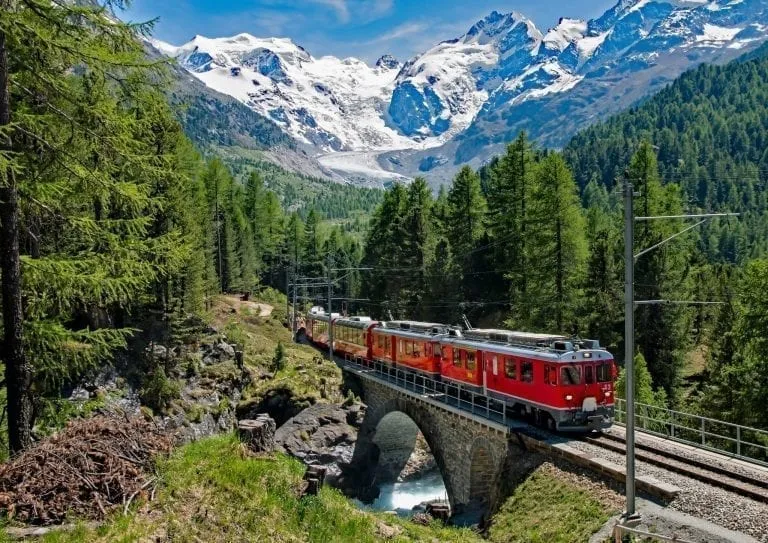

How to Travel Europe By Train: The Ultimate Guide (+ Tips!)
Beautiful views, comfortable train cars, the bustle of busy platforms, and the thrill of a new adventure: there are a lot of good reasons to travel Europe by train!
But, for those of us who grew up in a place where traveling by train isn’t common, the prospect of train travel in Europe can be as intimidating as it is exciting.
Thanks to traveling Europe extensively for years (including with our dog!) and spending more than a year living in Portugal, we’ve had a chance to appreciate countless train rides through and across Europe.
From the mind-boggling efficiency of Swiss trains to overnight train rides through Eastern Europe (Sofia to Istanbul was a particularly memorable ride) to simple jaunts across Italy, we’ve experienced just about every form of train travel in Europe.
And along the way, we amassed a huge number of European train travel tips !
This train travel guide is a culmination of everything we wish we would have known before we started traveling Europe by train , plus why we think it’s worth a try.
Table of Contents
Who is This Guide to Train Travel in Europe For?
Is train travel in europe right for you, different kinds of train travel in europe, different kinds of european train tickets, how to buy train tickets in europe, how to receive your tickets to travel europe by train, how to travel europe by train: step-by-step trip guide, useful tips for train travel in europe.

Some links in this post may be affiliate links. If you make a purchase through one of these links, we may earn a small commission at no extra cost to you. Please see our disclosure policy for more detail.
If you’re planning an epic, multi-destination trip and are hoping to travel by train through Europe but aren’t already comfortable with train travel on the continent, then this guide to traveling by train across Europe is for you!
We grew up in suburbs in the USA, and until we started traveling internationally in adulthood (4+ years of full-time travel , more than a year living in Lisbon, many trips across Europe, and counting!), we had virtually never taken a train.
W hile that’s certainly not the case for many people around the world, it is for thousands of our readers who grew up in similar environments to us!
If you’re excited to travel Europe by train but are learning the whole process from scratch like we once did, you’re exactly who we wrote this guide for.
While train travel in Europe isn’t exactly the same everywhere–with over 50 countries and therefore over 50 train systems, there are plenty of quirks based on location–this guide to train travel in Europe will give a solid overview that will help you start your travels with confidence.

Planes, trains, buses, rental cars, river cruises–with plenty of transportation options for getting around Europe, how do you know if train travel is for you?
In this section, we’ll break down the pros and cons of traveling Europe by train to help you decide if it’s the right transportation option for you.

Pros of Traveling Europe By Train
Taking a train across europe is a bucket-list-worthy experience..
For most of us who hail from other places, this is the number one reason to book that first train in Europe, right?
Traveling by train through Europe tops plenty of bucket lists around the world, and for good reason: it’s an incredibly fun way to explore the continent.
On some routes, the train ride is a travel destination in its own right–and even when it’s not, it’s a cultural experience to remember.
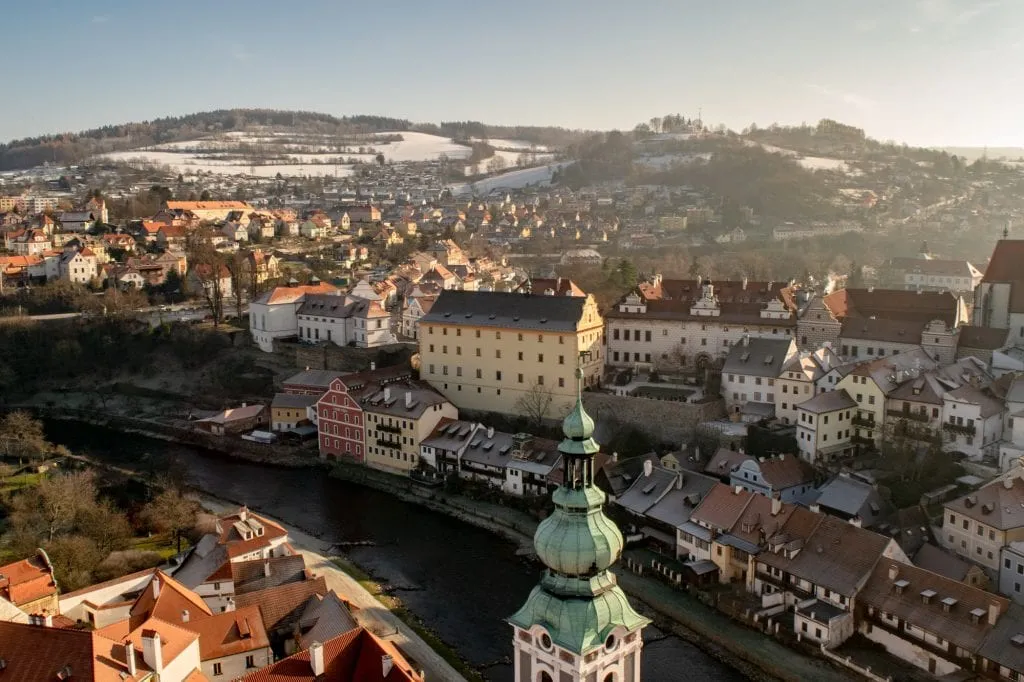
… and can allow for spontaneity.
For some routes, especially those with fixed ticket prices (more on that in another section of this Europe train guide), traveling by train allows you to be spontaneous, coming and going from destinations with much less foresight than is required when taking planes.
Depending on where you are, it can be very scenic.
If you have daydreamed about staring out train windows in Europe as you watch mountains, streams, seas, villages, castles, and vineyards go by, let me tell you… that’s pretty much exactly what it’s like a lot of the time!
Obviously not everywhere on the continent is scenic, but if you travel Europe by train, you’re likely to experience some truly incredible views along the way.

Most train stations are in the center of the city.
In our opinion, this is one of the biggest benefits to train travel in Europe!
W hile most airports (especially airports servicing budget flights) are located far outside the city centers, train stations are generally located right in the heart of the action.
Step outside the train station in Cologne, for example, and you’ll be looking at the cathedral.
In Florence , you’ll arrive less than a 10-minute walk from the Duomo .
In some places, like in Milan, Antwerp, Porto , and Paris’ Gare de Lyon, the opulent central train station is practically a tourist destination in its own right, so you’ll be exploring the minute you arrive, rather than spending hours getting into the city center from the airport.

No luggage limitations!
No one is going to weigh your luggage or make sure it is only a certain size on a train, so you can bring whatever you like (sports equipment and generally pets included).
Train travel in Europe is generally far more comfortable than flying.
At the end of the day, traveling Europe by train is immensely more comfortable than flying.
There’s less hassle, more comfortable seats, more ease of moving around, often better views, and more control over your environment.
If all else (price, time, etc.) were equal, we’d personally choose to take a train across Europe over a plane any day of the week.
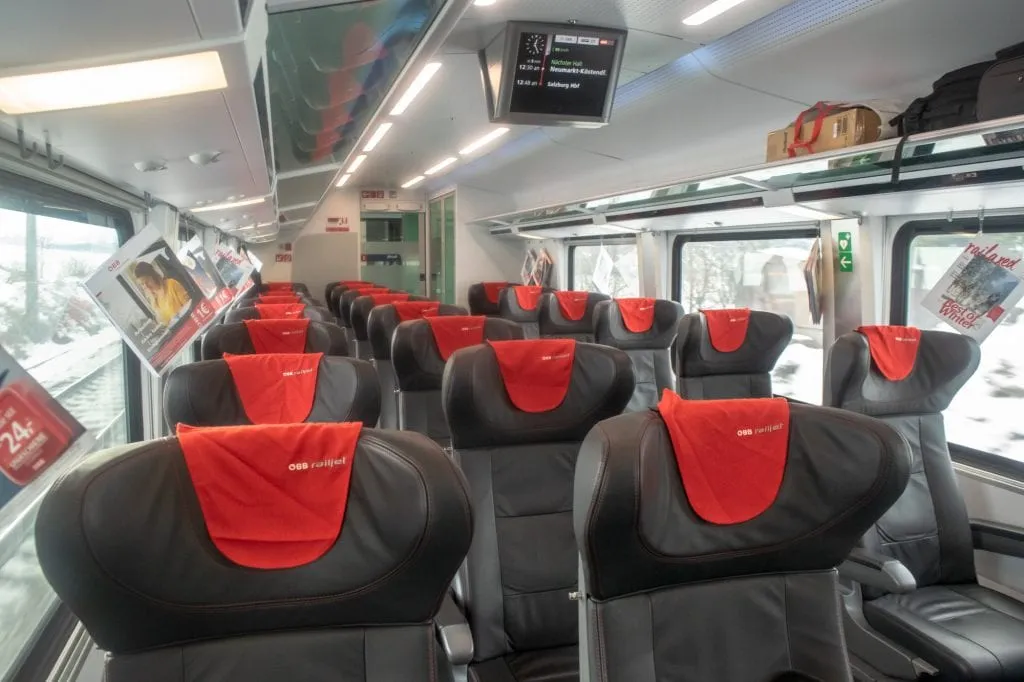
Cons of Traveling by Train Through Europe
It can get pricey..
When you first set out to travel Europe by train, you may assume that it is more affordable than flying–but thanks to a combination of several factors, including incredibly inexpensive budget flight carriers in Europe, that’s actually not the case.
Typically, it’s cheaper to hop on a budget flight between two major European cities than take a train.
The severity of the difference, though, can vary dramatically, and there are lots of tips you can apply to your train travel in Europe to mitigate the cost, which we’ll cover in this blog post.
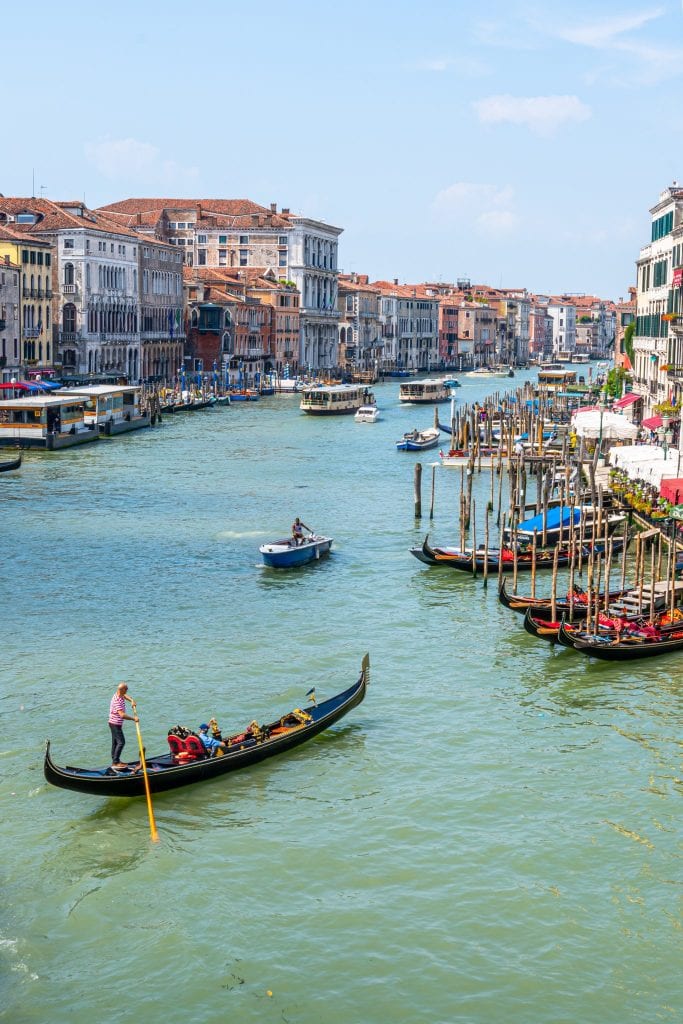
If you’re traveling long distances, train routes can take a prohibitively long time.
For example, when traveling from Paris to Venice , a route we’ve traveled by train, the train can easily take upwards of 10 hours, while the flight time is under 2 hours.
Now, that doesn’t account for getting to and from the airport, checking luggage, or going through security, all of which increase the amount of time a flight actually takes, but it’s still a large difference.
Train travel in Europe isn’t available everywhere.
As you move further into eastern Europe and the Balkans, train travel becomes much less prevalent (even popular Dubrovnik isn’t connected to the rest of Europe by rail).
A nd, when it does exist, can take longer and be less comfortable than planes or even buses depending on the destination.

Rail strikes can derail plans to travel Europe by train.
Generally, these are planned in advance, so you’ll know what you’re getting into before arriving, but they can be a bit of a hassle.
W e’ve had trips to both Italy and France impacted by rail strikes in the past.
If you have mobility issues, train travel can be difficult.
Lifting and storing luggage, navigating small staircases and bathrooms, and making your way through crowded train stations can be difficult if you struggle with mobility, so keep that in mind when deciding whether to travel Europe by train.
This is especially true with a short connection–we once had to literally sprint through the station to make a connecting train on time in Germany!

Traveling Europe by train can be a bit intimidating.
This isn’t a con, exactly, but there’s no doubt that the confusion surrounding train travel in Europe can prevent new visitors to the continent from trying it out, especially if they’re concerned about language barriers or navigating multiple countries.
If that’s your only hesitation, though, we urge you to set those concerns aside.
T raveling Europe by train is an incredibly rewarding experience, and well worth stepping a bit outside of your comfort zone for !

When discussing train travel in Europe, it’s important to remember that not all trains are created equal, or exist for the same purpose.
Here are a few general train categories to keep in mind as you plan your trip.
Metro/Intra-City Transport
Metros, aka subways (though some do run above ground) are public transportation used by a certain city.
While they are technically trains, metros are their own category entirely and this Europe train guide doesn’t cover them any further.
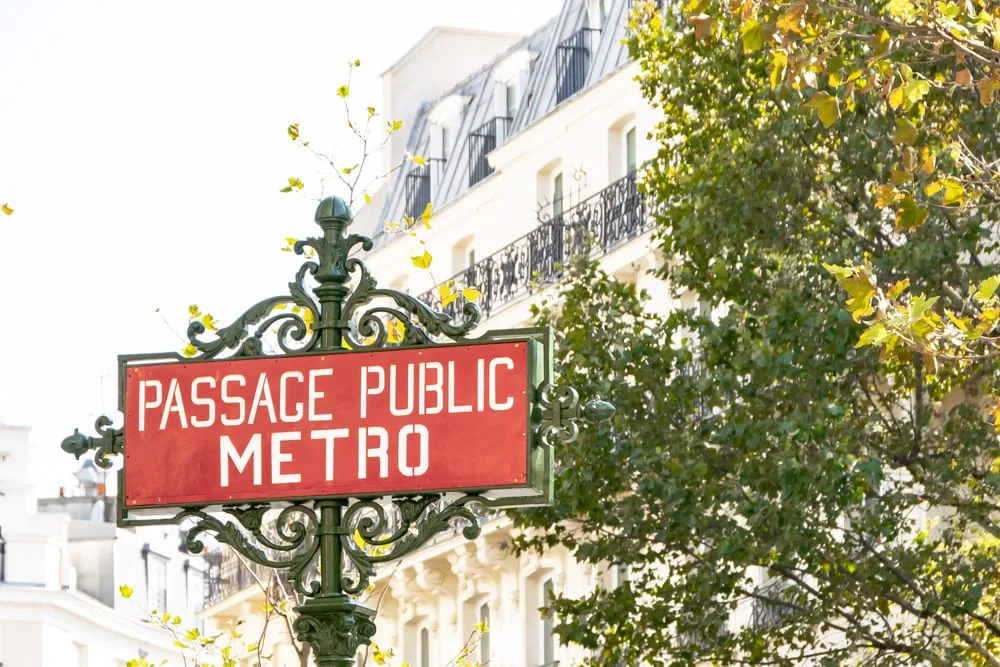
Commuter Rails/Regional Trains
Commuter rails and regional trains aren’t exactly synonymous, but for the purposes of this guide, they’re similar.
T hese are slower-moving trains used to connect surrounding villages to a major city (for example, Versailles to Paris) or trains that go within a certain country or region (for example, from Siena to Florence in Tuscany).
Most of the tips in this guide to train travel in Europe apply to these trains, but they sometimes have fewer amenities (like snacks/drinks available for purchase, for example) than high-speed or long-distance trains.
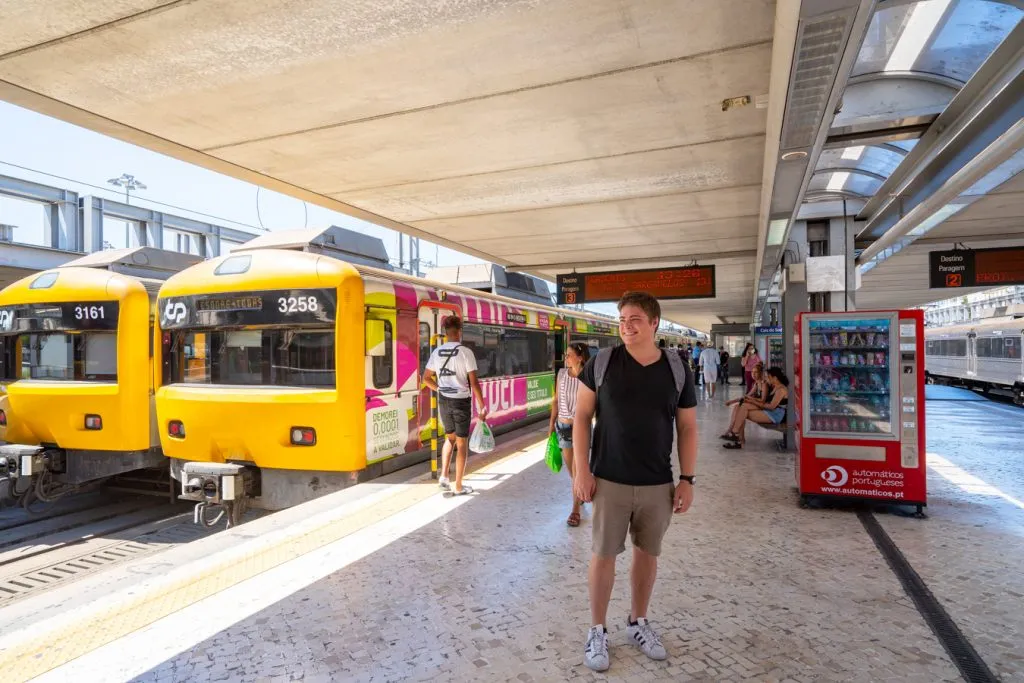
High-Speed Trains/Long-Distance Trains
These are trains that cover long distances within a country (for example, from Florence to Venice ) or cross borders (for example, from Paris to Amsterdam).
Since each country runs its own train system (often with a national carrier option and private carrier(s) mixed in), booking a ticket between countries may mean changing train companies at a city near the border.
For example, when we traveled from Paris to Venice by train, we took a French SNCF train from Paris to Turin, Italy, and then boarded an Italian Italo-branded train to travel from Turin to Venice–all booked on the same ticket.
These high-speed and long-distance journeys are the primary focus of this guide on how to travel Europe by train.

Tourist Trains
These are trains that, while technically public transportation, are typically used as tourist attractions for sightseeing purposes, and are priced accordingly.
Examples include the Glacier Express or Schniyge Platte in Switzerland, or the Jacobite Steam Train (aka Harry Potter train) in Scotland.

Sleeper Trains
Technically, sleeper trains aren’t their own category–they’re just long-distance trains with sleeper carriages in them–but they’re worth calling out separately in this guide to train travel in Europe because they’re particularly interesting for travelers.
Not only are sleeper trains a great way to save on hotel costs for a night of your trip, but they can also be quite the travel adventure in their own right!

Before you start looking into buying train tickets, there are a couple of terms to be familiar with:
First vs. Second Class Tickets
When traveling via train in Europe, you’ll generally have a choice between first and second-class tickets.
Buying a first-class ticket generally comes with slightly larger seats, sometimes the ability to reserve your exact seats when you can’t in second class (both of those facts vary based on the company you travel with), and possibly a small snack like a water bottle and a pack of cookies.
In our earlier travel years, we never used to consider these perks worth the money–but I’ll admit, as we started traveling with more luggage and most importantly, our dog Ranger, we started splurging on first-class more frequently.
The extra space can definitely come in handy if you have more than a suitcase with you!

Variable vs. Fixed Price Tickets
Variable-price tickets, as the name implies, tend to increase in price the closer your date of travel gets.
T hese tickets are generally used for high-speed trains and long-distance journeys and will be the most common form of ticket you see when traveling between countries by train in Europe.
Fixed-price tickets are more typical for regional (aka “slow”) trains and can be booked at any time–so you can just show up at the station and buy them from a kiosk without issue.
For example: if you travel from Florence to Bologna on a high-speed train, it will take around 30 minutes and that ticket has a variable price.
If you travel on the regional train that takes around an hour, the price is fixed and you can book it at any time.

When you travel Europe by train, one of the first things you’ll need to get the hang of is exactly how and where to buy European train tickets–and you have plenty of options!
Here are different ways to obtain train tickets in Europe.

Online (Via a Third-Party Site)
Third-party booking sites are incredibly useful when preparing to travel Europe by train, especially when you’re planning to travel between countries.
We use and recommend Omio , which will allow you to easily compare prices between different routes, show you the most efficient path, and allow you to book trains across Europe with no concerns about language barriers, iffy online translations of national websites, or issues with payment (some company websites struggle to process foreign credit cards).
Omio is a ticket aggregate, and searches multiple companies and routes at once, which makes it very handy for checking train timetables and possible routes as well as for booking tickets!
Search train routes and tickets prices in Europe today!
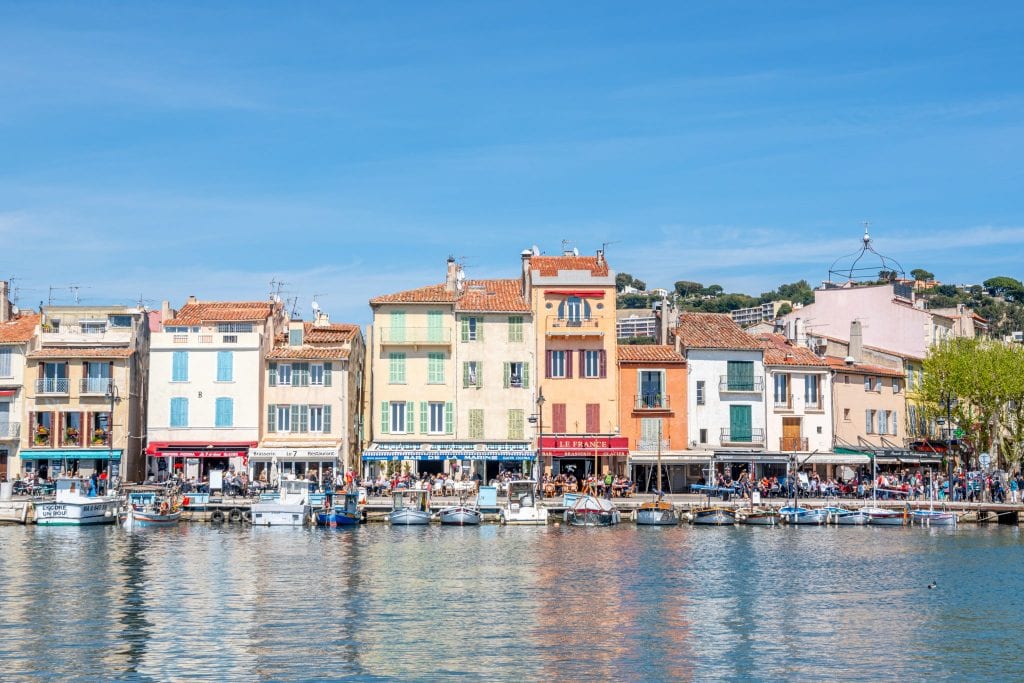
Online (Via the Company Directly)
Alternatively, if you’re looking for the best possible deal, you can book tickets online through direct websites for most countries in Europe.
For example, here are the national train company websites for Italy , France , and Germany .
We tend to book directly whenever we’re traveling domestically in a place we’re very familiar with, like Italy.

At the Train Station
If you’re traveling a short distance on a regional or commuter rail (like to take a day trip, for example), you can also buy tickets directly at the train station.
If you’re buying train tickets in person, we recommend using the kiosks available whenever possible.
Not only do they tend to have language options that make things much easier, but they also tend to take a fraction of the time of waiting in line to be helped by a person directly.

With a Train Pass
The final option for booking tickets to travel Europe by train is to do it in one fell swoop with a Eurail pass (for non-European residents) or Interrail pass (essentially the same thing, but for European residents).
Essentially, a Eurail pass will allow you to buy a certain number of train rides (or an unlimited number) in advance, allowing you to be more spontaneous in your travels.
However, there are limitations–for example, some routes still require advance reservations and charge additional fees.
G enerally speaking, the average user will end up spending more on train travel in Europe with a pass than without one.
There are cases where a train pass makes sense, though, so if you’re planning lots of European train travel, especially in Western and parts of Central Europe , be sure to run the numbers to see if a European train pass is right for you!
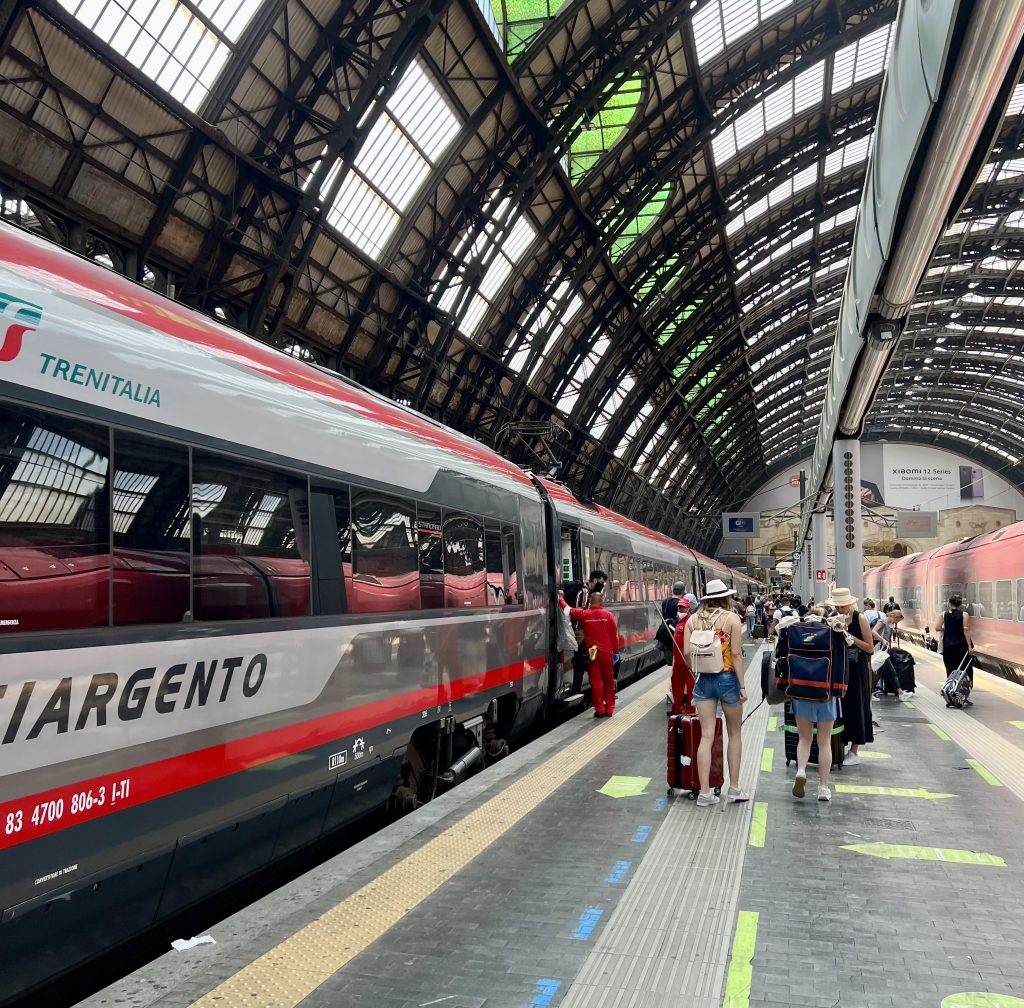
Once you buy your tickets, the next step is to actually receive them!
Here are the three main options.
Most European train tickets these days can be received online and downloaded to your phone.
When available, this is by far the easiest and quickest way to receive your tickets.

At the Station
You can also choose to receive your (paper) tickets at the station you’re departing from, either by purchasing them there as mentioned above, or by picking up tickets you bought online.
In most cases, there’s no real reason to pick up paper tickets you bought online as opposed to simply downloading them, but most countries do still have the option.

If you book tickets to travel Europe by train well in advance of your trip, many countries do also have a home delivery option where they can be mailed to you before you travel.
We took advantage of this for our very first multi-country trip to Europe and had our train tickets for our overnight route from Krakow to Budapest mailed to our then-home in San Antonio.
Honestly, it was complete overkill, even as the novice travelers we were then, and we don’t necessarily recommend doing this–but some places do have the option available.

If you’re confused, concerned, or just slightly intimidated by train travel in Europe but are ready to book your first journey, this section is for you!
Follow these instructions step-by-step, and you’ll travel Europe by train with ease.
Book your ticket.
Generally, for long or inter-country journeys, booking online is the easiest option as we outlined above.
We use and recommend Omio for booking train tickets in Europe.
Shop train tickets across Europe today!

Make sure your ticket is in hand.
This can mean downloaded onto your phone or printed onto a piece of paper in your hand.
E ither option works in most places, but whichever you choose, make sure you have your ticket handy when you board.
Head to the (correct) train station.
Most major European cities are home to more than one train station, so be sure to double and triple-check that you’re going to the right one before you set off.

Find your platform.
Much like in an airport, your first step to finding your train platform will be to check the (often large, sometimes confusing) boards bearing destinations and times.
It’s best to search for your train based on a combination of the train number, company, and departing time– not the destination.
If your train is continuing past your stop, for example, searching by destination can get very confusing, very quickly.
European trains (and Europe in general) also use the 24-hour clock (so 3:00 PM will be displayed as 15:00, etc), so keep that in mind when looking for your train on the departures board.
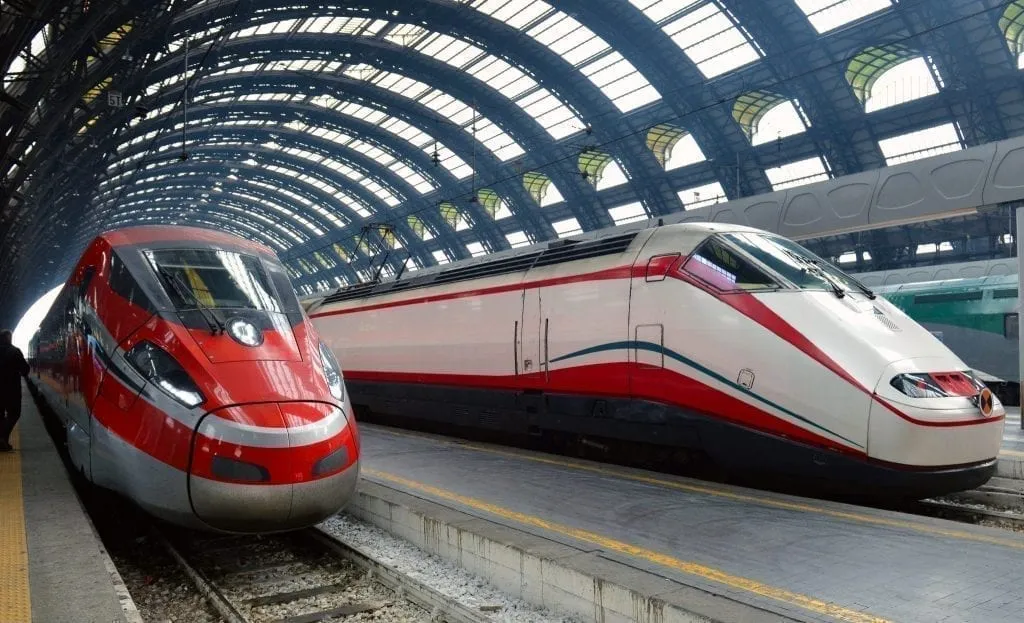
Validate your ticket.
If you have a paper ticket, you’ll need to validate it before you board.
T he kiosks to validate your ticket are generally placed just before you reach the platform, but can sometimes be easy to miss if you’re not looking for them.
(As far as we’re concerned, this hassle is another point in favor of online/downloaded tickets.)
If applicable, find your train car and seat number.
If your train has reserved seats, you’ll need to find the exact train car number and seat number to sit in.
T his is most common on long-distance, high-speed trains.
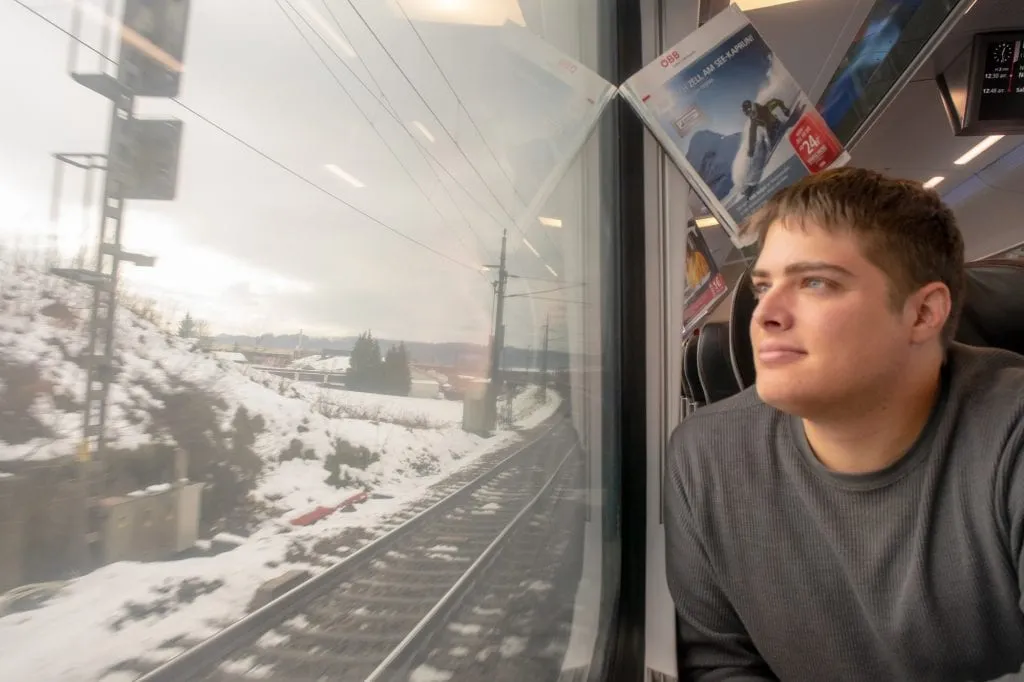
… Or just look for the appropriate class.
If your train has open seating, the only seating concerns will be whether you sit in the 1st or 2nd class.
The “1” or “2” denoting whether it’s a first or second-class train car is generally marked obviously on the side of the train, near or on the door itself, so it’s fairly easy to make sure you’re in the correct place.
Stow your luggage.
In some trains, this will mean storing your luggage in the racks provided at the ends of each train car, in others, it will mean in the racks above the seats, and in still others, there are even places to store bags between the seats.
Keep an eye on what others are doing, but keep in mind that as long as your luggage isn’t in anyone else’s way, there’s generally some flexibility to the process.

Settle in and enjoy the views.
Once you’ve found your seat and stored your luggage, it’s finally time for the best part of train travel in Europe: kicking back and enjoying watching the world go by.
No matter how many times we ride trains through Europe, we never stop getting a little thrill during this part of the process!
Keep your ticket handy for when the conductor comes by.
At some point, as you travel Europe by train–and it could be 5 minutes into your ride, 5 hours into your ride, or both–a conductor will come by to check your ticket.
Be sure to have your ticket in a convenient place so that you’re ready when this happens!

Listen carefully as you get close to your destination.
As you begin to get close to your destination, it’s time to pay very close attention to the announcements.
Many European cities have train stations that sound very similar to each other, especially to those not familiar with them (for example Roma Tiburtina and Roma Termini), and you’ll want to be certain to exit the train at the correct stop.
O therwise, you might accidentally find yourself deep in the suburbs instead of in the center of the city!
In many places, especially along routes popular with tourists, arrival announcements for each station will be repeated in English, but that’s not a guarantee.

Exit the train quickly and smoothly.
When you reach your stop, be ready to exit immediately–that means luggage in hand and waiting at the end of the train car to exit.
You’ll generally see people start to queue up a few minutes before arrival.
The train stops long enough for everyone to exit comfortably, so you don’t need to push past other people or even hurry if you’re prepared.
However, if you wait until the train stops before even getting your luggage together, well–if your station isn’t the final stop, you might find the train moves on before you have time to get off.

If you have your heart set on traveling Europe by train, plan ahead.
As you plan your Europe itinerary , you’ll likely find that some destinations are better suited for traveling Europe by train than others, and it definitely pays to know which destinations require a train, plane, or bus before arriving in Europe.
Train travel in Europe is generally best suited for certain Western and Central European countries–the further you move into the Balkans and Eastern Europe, the more limited (and, shall we say, adventurous) it becomes.
And, despite being situated essentially as far to the west of Europe as you can get, Spain and Portugal are surprisingly isolated from the perspective of train travel (this is due to having a different size of railroad gauge than other countries in Western Europe).

Distance also plays a key role.
Traveling from Paris to Venice by train is a long but completely doable day, but Paris to Zagreb , not so much–that route is better suited to a plane.
Add in the fact that you’ll want to book your variable-price tickets in advance, and the bottom line is that you should definitely bank on planning at least the most important routes in advance.

Definitely book complex routes for train travel in Europe in advance.
If you’re traveling from Rome to Florence or Madrid to Barcelona, especially if you don’t mind taking a regional/slow train, you can book your train tickets once you already arrive in Europe.
For more complex or longer routes, though, you’ll make things much easier on yourself if you book before you start your trip abroad.
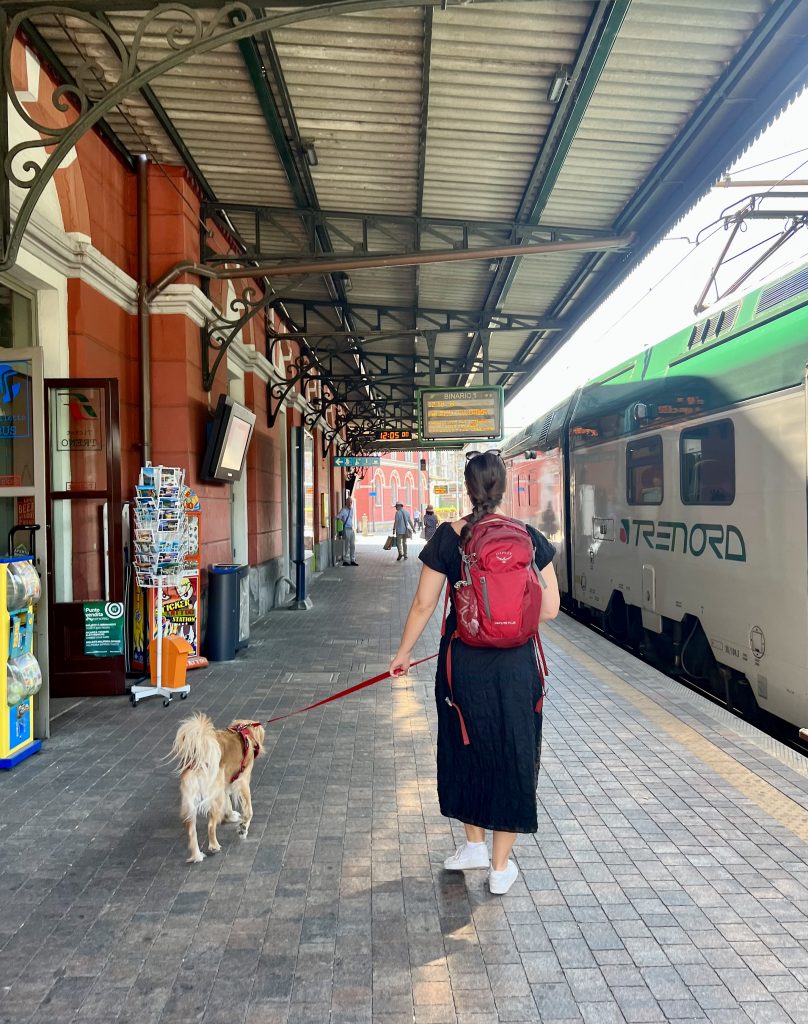
Bring snacks and drinks along for the ride.
While most long-distance routes will sell simple food on board like sandwiches, drinks, and pre-packaged snacks, the selection is generally about on par with airplane food, in other words, expensive and unexceptional.
Commuter and regional trains are much less likely to sell food on board.
On long-distance trains, there’s typically a dining car you can visit to make purchases, and on some routes (especially in first class), a restaurant cart will come around offering a few items, similar to a flight attendant.
Better not to worry about it, though: we recommend packing plenty of snacks (or even a full meal) and drinks to bring along, which is completely typical on trains in most places in Europe.

If you have a long train ride ahead, consider packing cards or a game.
Not only will this help entertain you throughout the journey, but it’s also a great way to meet other travelers!
Don’t count on having internet access onboard.
Even if you have a European SIM card and are traveling within the Schengen Zone (where SIM cards are supposed to work across borders), maintaining an internet connection on a European train ride is iffy.
B etween tunnels, remote countryside, border crossings, etc., it’s best not to count on having access.
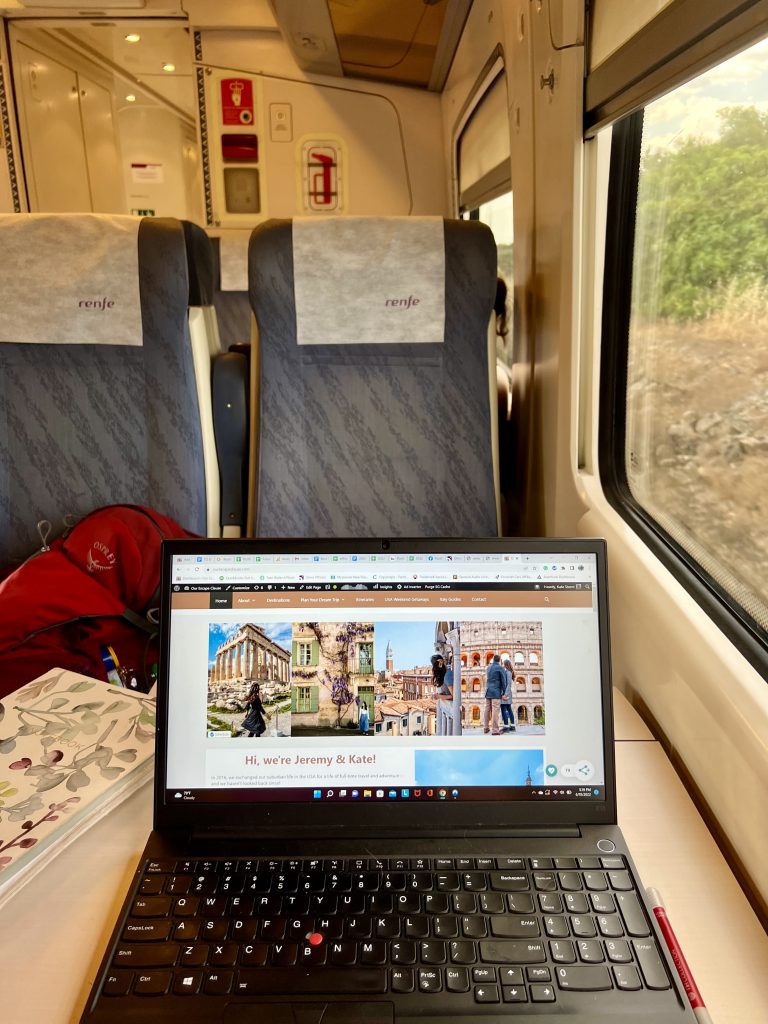
If the train advertises wifi, don’t count on that either–some of them require a local tax ID number or phone number to access.
We’ve found that our best bet for internet access during train travel in Europe is whenever the train briefly stops at a station.
If you have a SIM card that works for that destination, you can usually expect at least a few minutes of connectivity there.

Make sure you go to the correct train station.
We mentioned this above, but it bears repeating: be very certain that you go to the correct train station when traveling by train through Europe… and that goes for when you get on and when you get off!
… And show up early.
Some train stations in major cities are enormous, and can almost resemble airports, with 30+ platforms, various levels, and in some cases a mall inside them (like Roma Termini, for example).
If you’re not familiar with the station in question, be sure to leave yourself plenty of time to find your way to the correct platform once you arrive!
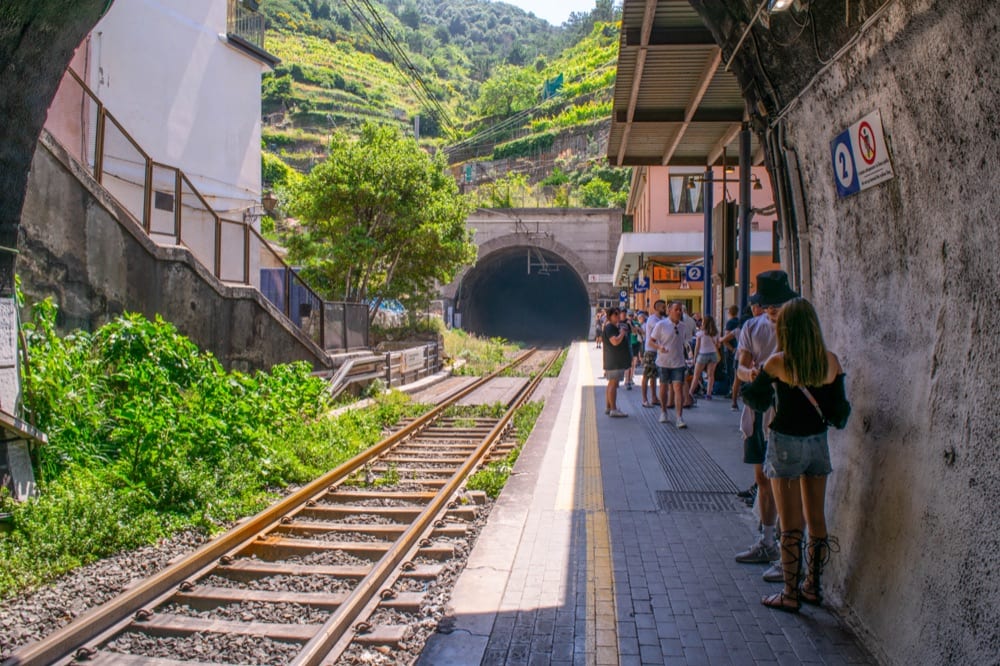
If you have an opportunity to take an overnight train, do!
Not only is it a great way to save on the cost of a hotel for the night , but spending the night in a sleeper car can be quite a travel adventure!
(Though in the interest of full disclosure, I have never once gotten what I would call a good night’s sleep on a train. No regrets, though, and we’ll do it again!).
Toilets are plentiful, but their quality is questionable.
In other words, bring some toilet paper (I usually keep a small packet of tissues handy for that purpose) and hand sanitizer.
Also, wet floors aren’t exactly unheard of, so you might want to stick with close-toed shoes.
Most high-speed trains in Europe have a toilet available in every train car, so you typically won’t need to go far to find one.
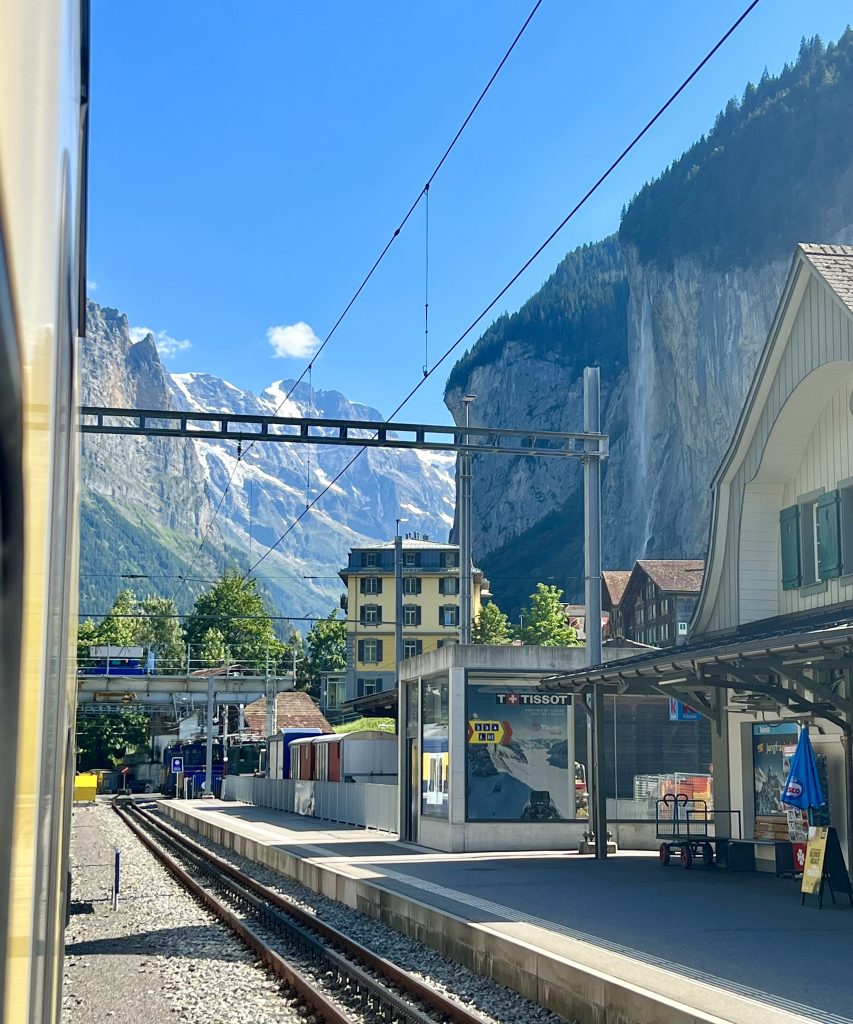
If you’re a student and/or under 26, you might qualify for discounts.
Keep that in mind when booking your train tickets for Europe, and if you do book a discounted fare, be sure to keep your ID handy (it’ll likely come in handy in many other places during your trip, too).
Keep in mind that some under-26 discounts are only available to EU residents, so be sure to verify that before counting on them if you aren’t European.
You can generally bring dogs (and cats) with you on trains in Europe!
This is a bit beyond the scope of this blog post, but given that we have several photos of Ranger in here, I’m sure at least a few readers are curious!
The vast majority of trains in Europe allow well-behaved companion animals on board, with varying requirements and costs (generally either free or the price of a child) based on the animal’s size, whether it’s confined in a carrier, etc.
It’s best to check the expectations for each route in advance, but with a little planning and flexibility, your furry friends are generally welcome.
Ranger is quite the traveler and has visited 8 countries and counting with us, many of them by train!
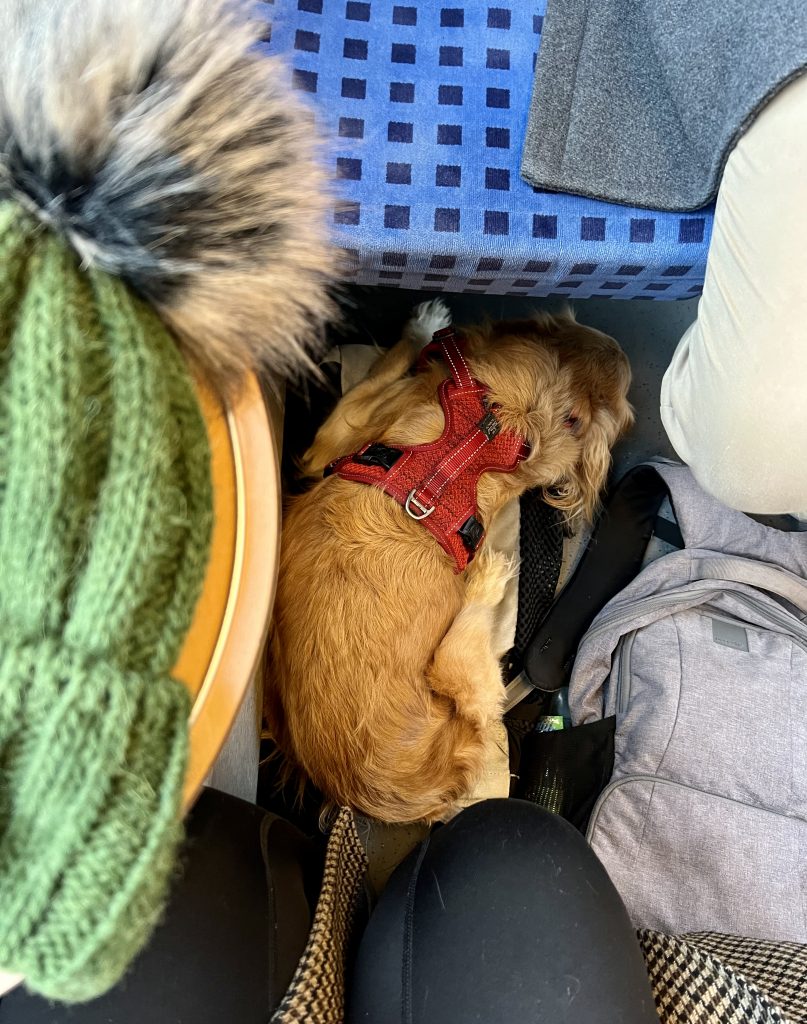
Keep an eye on social norms.
Cultural expectations around eating, talking loudly, and storing your luggage can and will vary depending on where your train travel in Europe takes you.
B e sure to keep an eye on what everyone else is doing to ensure you’re not inadvertently committing a faux pas !
For example, if you take a train, say, in Italy and then later in Austria as you travel Europe by train, you’ll likely notice a huge difference in the noise level on the train!
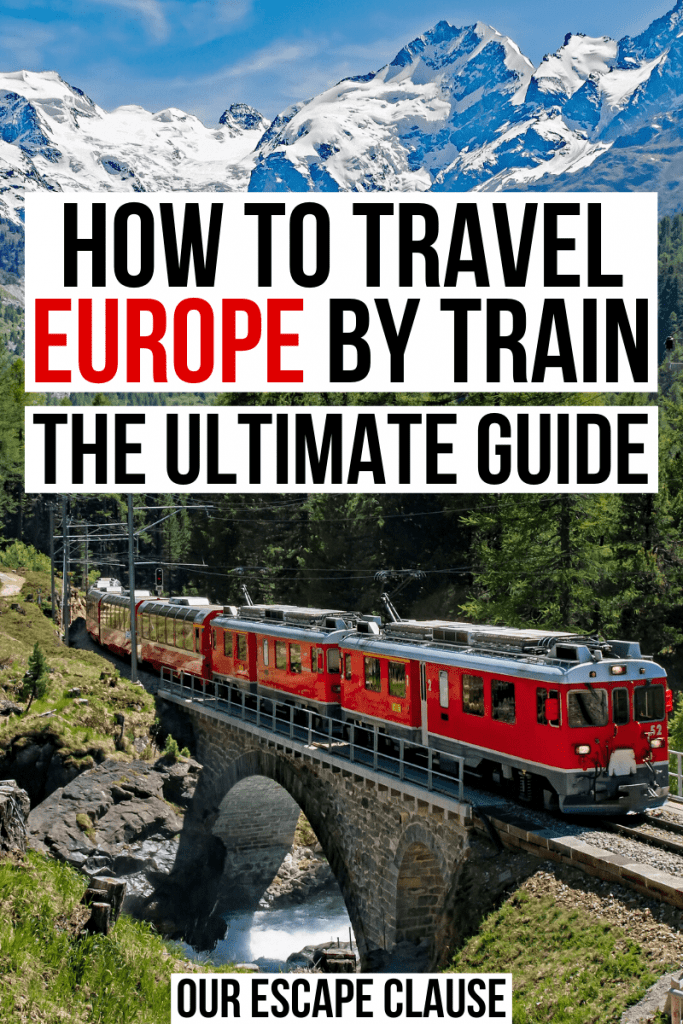
About Kate Storm

In May 2016, I left my suburban life in the USA and became a full-time traveler. Since then, I have visited 50+ countries on 5 continents and lived in Portugal, developing a special love of traveling in Europe (especially Italy) along the way. Today, along with my husband Jeremy and dog Ranger, I’m working toward my eventual goal of splitting my life between Europe and the USA.

64 thoughts on “How to Travel Europe By Train: The Ultimate Guide (+ Tips!)”
We are senior citizens planning a trip to Italy and surrounding areas in September 2022. Looking at some train travel, multiple cities for sight seeing. We like the smaller, picturesque, historical cities. What advice can you offer?
I definitely recommend searching “Italy” on our search bar (top right of the site on desktop, part of the menu on mobile). Italy is one of our favorites and we have (literally) about 100 posts about it!
For small, picturesque, historic cities, Siena, Venice (it is pretty small!), and Verona come to mind. Florence, too–surprisingly small in some ways!
For even smaller hilltop villages like Montepulciano, etc, in Tuscany, be aware that many of the train stations aren’t in the town center, so you’ll likely want to catch a taxi in many of them to avoid hauling luggage up a hill.
Two years ago we had a small villa in a very small town in Italy. We trained to a new place everyday. It was funned and easy. We took the local bus into the next target town, bought our tickets at the station and took off for the day. We went to Florence, Pizza, and several smaller towns. We are mature seniors and had no trouble getting around. Only a couple of people spoke english in a small town, but, we managed easily.
Your comments encourage me to locate a home base in Italy and take a train or bus to the surrounding suburbs etc. I’m no spring chicken nor my husband but we get around easily. Thank you
Thanks for the helpful information. Appreciate it!
My boyfriend and I just booked our first train tickets in Europe thanks to you!!! I’m so happy we found your blog. We’re going to France and Spain this summer!
Ahhh that is wonderful to hear! Have a fantastic time!
My wife and I, both 70 are taking a cruise from Budapest to Passau and plan on taking trains to Birmingham England from Passau. I’ m planning about 5 stops. First Venice then Tirano, St. Moritz, Sion, Strasbourg and finally Birmingham. I plan on a Eurrail pass. do you have any advice, help or suggestion. Thanks
Hi Wayne! If you’re planning on an Eurail pass, my best advice is to research your routes, dates, and times in advance–many popular routes will still require advance reservations even with a pass.
Kate, my wife and I are planning our first cruise in Europe, and are thinking about taking the train from Barcelona to Rome (cruise departure). Your blog was a great overview. My question has to do with ability to get off and on a subsequent train, for day visits on the way. Is switching covered or individually arranged ahead of time, and is it a good or bad idea for novice mostly monolingual travelers to Europe? Advice? Thanks,(Chuck)
If you book a ticket from Barcelona to Rome, your ticket will be good for that specific train/departure only, so you can’t get off and back on at various stops. If you want to stop places along the way, you’ll need to book individual tickets between each destination you plan to visit.
If you have your heart set on that, look into an Eurail pass–it does what you describe, however, it can get confusing (some routes still require advance reservations) and will usually be more expensive than booking tickets individually.
Traveling by train is absolutely doable as a novice traveler, but be sure to be careful when you’re booking your tickets (to ensure they’re the right dates/times/train stations you expect), and pay close attention to the stops to ensure you don’t miss yours.
Another option, if you’re traveling during the summer and want to get from Barcelona to Rome quickly without flying, would be to take a ferry to Rome and then train to a few places around Italy from there.
Hope you guys have a great trip!
My family is looking to travel from Lille to Amsterdam. My question is: when we depart out train that originated in Lille and transfer to a new train in Brussels, will we need to go through some form of customs before we board the train for Amsterdam? I just want to get an idea of how much time to leave for connecting trains.
Hi Matt! No customs required–all of those countries are part of the EU Schengen Zone, so moving between them via train is generally as seamless as road-tripping between US states.
And, is 33 minutes to connect from one train to another a lot of time? We have never done this type of thing before so I’m not sure if that is cutting it too close
33 minutes should be okay! Definitely move with purpose to find your next platform once you arrive, but you shouldn’t be in a huge hurry as long as everything is on time.
Kate- I am considering coming to Europe early for my Christmas river cruise heading out of Brussels. I was thinking of taking the train from the Brussels airport to Koln to see their markets and explore, and then doing a day train up to Dusseldorf to see their Christmas markets. It looks like about a 2 hour train ride on Thalys to Koln and then only about 30 minutes from Koln on to Dusseldorf. I will then take the train back to Brussels for my riverboat cruise. Does this sound feasible?
As long as the timetables work in your favor, I don’t see why not! Germany and Belgium are both great countries for exploring by train.
Hello Kate, We are looking to visit Italy for the first time in December/2022, I was looking in the train tours, visiting 4 cities (Rome, Florence,Venice & Naples). Your thoughts on train tours? Thank
Hi Sharon! I’m not sure what you mean by tour–if you mean a guided trip, they can of course be very fun with the right group, but I wouldn’t say you need one for this route.
All of those cities are very simple to visit independently by train, and we have taken trains to and from all of them many times (I’m actually typing this on a train to Venice).
Hi Kate, my husband and I are planning to fly in to Italy and travel by train to the following places: 1) Milan 2) Switzerland 3) Vienna 4) Prague 5) Paris
May I know if these places can be connected by train. If yes which train will you recommend, please. We are actually thinking about 15-20 days to cover these areas. As it’s our first Europe trip, do you think it’s sufficient and is there any place along the way that you would encourage to go. Thank you.
Yes, those are all excellent destinations to visit by train, so you’re good to go there. As far as specific trains, you’ll need to pull up the individual routes to check (we recommend Omio for this, especially with cross-border trains).
That’s definitely too many places for 15 days, though, and still pushing it at 20. I’d recommend trimming the itinerary a bit if you can (or adding on extra days, of course!).
Hi there This was so helpful. My husband and I are going to Amsterdamin September and then 3 nights in Bruges. All us booked but I’m overwhelmed but the trains websites. Omio is the easiest but I’m still leary. Is it legit and a decent safe way to book trains? We are only going to Belgium. Then two days to the countryside in The Netherlands which we will just grab a regional train. Everyone is telling us to book the train to Bruges. Any helpful advice would be great. We would go to Antwerp and take an IC train to Bruges an hour later,as my husband does have hip and knee problems. Thanks in advance.
I understand, it’s a lot to take on the first few times!
We use Omio regularly, as do many people we know, it’s perfectly legitimate.
The Antwerp train station will be a beautiful place to rest for an hour. It’s absolutely stunning, especially the front foyer, and often pops up on lists of the best things to see in the city!
Hi Kate, My husband and I will be traveling from Prague to cities in Austria and Germany by train next month. We have used trains a few times in Europe before, but it was pre Covid. It looks like most Covid restrictions have been dropped, but I wondered if you have to show Covid vaccination cards on the trains?
Thank You, Jaymie
I’m always hesitant to answer questions like this because I feel like I’ll be summoning disaster with how quickly things can change, LOL.
But at the moment, no, you won’t need your vaccination proof in either place as far as I know.
Life is pretty 2019 these days when it comes to the logistics of traveling around Europe as a visitor, though a handful of places still require masks on public transport (I think Vienna is one of them, but again–things change!).
This is so helpful, but I’m striking out with trains from Naples to Rome? It says that there aren’t any? Why would they list it as an option if they don’t travel to there? Also, is there a way to preview how long the train rides are to decide if we want to travel to certain cities? Cannot find any train tables. I find the Omio and Eurail sites to be difficult to navigate and I can’t get enough information to plan! :( Does it make sense to buy a eurail pass first and then research times and etas? Any help is appreciated!
Trains from Naples to Rome definitely exist! It’s possible you’re looking too far in advance to book the tickets–on Omio right now, it looks like I can purchase Naples to Rome tickets up to about 6 months out.
When you search for a specific route on Omio, Trenitalia, etc, it’ll show you how long the train is and how many changes there are, if any, much like searching for a flight.
We don’t recommend using the Google tool for this, as it tends to default to how to get somewhere if you leave at that second, which can be confusing and normally involves a more complicated route than you need.
Personally, we don’t generally find Eurail passes to be worth it in terms of cost-savings for most travelers, but in terms of research, you’ll be working with the same information either way. :-)
Hope that helps! It can be a bit confusing at first, but if you try practicing by looking at dates sooner than when you actually plan to travel, I think you’ll find the information you’re looking for.
Thank you for taking the time to write all that useful information. It is so much appreciated by many of us! :)
Like many of your readers, we are (two young adults) planning to visit Europe for the first time this upcoming May. We are currently looking at: Landing in the morning in Prague, spend 1 or 2 nights, then Vienna, one night, leave following morning for Bratislava (this one is a maybe, it’s so close!) OR Vienna to Venice. Spend 1-2 nights, then Zurich, and finally Munich, before we make it back to Prague to catch our returning flight. We are looking at 9 days from the morning we land. 🥴 We figured it would be more efficient to travel in a circle, as some destinations -like Paris- will be out this time around. :(
Thoughts on that? I will look into Omni regarding trains, but our plan is to travel only by train, if possible.
I know that’s a lot of questions, but THANK YOU so much for your help! 😊
Thanks so much, Al! So glad to be helpful. :-)
You definitely have the right idea with traveling in a circle, though I definitely recommend trimming some destinations!
With 9 days, I’d suggest no more than 3 base cities (and that’s pushing it), and you can add a day trip or two from there if you like.
I know it’s SO tempting to add more places (I have this problem constantly myself lol) but you’ll have much more fun with a bit of time to explore each place!
I’m not sure what your priorities are or what your budget is, but based on the cities you listed, I’d cut Zurich (Switzerland is amazing, but you don’t have time) and Bratislava. Ideally, I’d suggest cutting one more city as well.
If it were my trip, personally, I’d do a Prague – Venice – Munich triangle, and potentially day trip to Neuschwanstein Castle or somewhere else in the Bavarian Alps with one of the days in Munich. That’s just personal preference, though!
You can definitely do all the destinations you listed by train, no issue there at all. :-)
That recommendation sounds amazing. The two big ones are Prague (#1!) and Venice, but really hoping to do Munich as well.
I will look into the Bavarian Alps, as I am not familiar with them :)
Thanks again. Really enjoy reading through your content! 😊
If you love mountains and/or castles, you’ll definitely love them!
Enjoy some Czech beer for us :-)
Hi, we are doing Europe by train in June. Is there a way to determine: a. which direction the train(s) are going, so we can face forward? b. Which side is considered the right side (vs left side) for best views when recommended? Thanks for your perspective.
Unfortunately, there’s no clear-cut way to determine which way trains are facing, especially because they often turn around during the route, depending on how they pull into/out of various stations. On long journeys, it’s not uncommon to find yourself facing forward part of the time and backward part of the time.
If you’re starting from the beginning of the line, you can sometimes tell which way you’ll be facing at the beginning based on the route, but not always.
The same goes for the views–for very specific routes, you can sometimes get personalized recommendations from others who have traveled the route (especially for particularly scenic ones), but there’s no simple solution to figuring it out beyond just recommendations.
It’d certainly be easier if that were the case!
Hi Kate, Really enjoying your posts, photos, and appreciate the helpful advice. I am planning a trip in Sept/Oct to visit Scotland for a week before traveling in southern Germany and Austria. What would you recommend about getting from Scotland/London to Koln, Munich or Frankfurt? Is there a good train route to take? Or is this a case where flights make more (economic or time) sense? Thanks for any pointers!
That’s definitely a route that is better served by flight, both from an economic and time perspective! :-)
Is there something I am missing about Omio, the booking site that you recommend?
My wife and I are moving to Lyon in April and plan to go to Amsterdam in May. I went on the Omio site just to get a sense of what was available from Lyon (Gare Part Dieu) to Amsterdam (Centraal) on a random date (I picked May 9) and the site told me it could not find any trains between these places. But on the Rail Europe site, it showed a slew of trains available throughout the day.
I am confused.
I am too, I’m not sure why it’s not coming up! I just did the search myself and played around with dates, destinations, etc. Paris – Amsterdam, for example, seems to be pulling up just fine.
Could be as simple as a bug, but I just shot Omio an email asking for clarification.
Hi Kate I am Josh from KL Malaysia looking forward for europe trip in september 2023. I would like to start trip from berlin to budapest for 15 to 17 days.how to go about it by using eurorail?
Eurail has a website with a planning tool that can help you sketch out your journey.
Generally, you’ll buy either a set number of travel days within a given time period (like 7 days to be used in a month) or an unlimited pass.
Many routes do still require advance reservations (with additional fees), so be sure to check each route individually so you don’t miss anything!
Hi! I would love to travel as comfortably with my dog as you have, seeing from the pictures. I have a couple of questions: 1) what’s the name brand of that pet carrier. Looks perfect for mine. 2) Could you post tips on hoe to travel with your pet successfully.
Thank you for your content!
Yes, absolutely–with a catch (if you’re in the US). We bought the bag on Amazon Spain when living in Portugal and don’t know of an equivalent here. But this is the link: https://www.amazon.es/-/pt/gp/product/B00XR2D94W/ref=ppx_yo_dt_b_asin_title_o07_s00?ie=UTF8&fbclid=IwAR3p0Ihrxf6e1yL4nJv5pJBK0GXmOIVIqXL97ov77VRuxSIvm61M2-NbfQE&th=1
Here’s Ranger’s backpack that he gets carried in as well (size large): https://www.amazon.com/gp/product/B07C9XLXVH?ie=UTF8&th=1&linkCode=ll1&tag=ourescapeclau-20&linkId=813c9a64c05de1faef0162cbed102f22&language=en_US&ref_=as_li_ss_tl
He absolutely loves both–gets so excited when we get his bags out, and climbs right in when we get onboard!
Traveling by train in Europe with a dog is usually pretty simple, but you’ll always want to look up requirements for the specific country/train company (some require dogs not in a carrier to pay a half-fare or child’s ticket, etc).
If your dog is very small (like a yorkie or similar) they’re usually free, though again, be sure to check in advance.
I have it on my list to write a whole blog post on this topic eventually, but I hope that helps get you started! :-)
Just wanted to say thank for you for such amazing content. We are starting to plan a 5 week trip to Europe for Summer 2024 with our 4 kids and your site and recommendations are beyond helpful.
Thank you so much, Megan! That’s wonderful to hear. :-) Hope you guys have an incredible trip!
Hi, planning a trip to Europe with the family. Have been to Italy, Spain, Portugal, France and UK so we are looking for something different. Like Berlin, Prague and Vienna or Amsterdam, Berlin and Brussels. Love to get your thoughts on these routes and would you recommend taking the train between these cities? Or any other 3 cities you recommend we do over 10 days.
Sounds like a very fun trip! All of the cities you mentioned are definitely doable by train, but Berlin-Prague-Vienna is more cohesive than Amsterdam-Berlin-Brussels (I also personally would put a couple of dozen other cities in the region ahead of Brussels, though it definitely has things to offer!).
Since it seems like Berlin is a priority for you, I’d recommend using that as your anchor and spanning out from there.
A few other places that could make sense, if you want to add more options to your list, could be Krakow, Budapest, or Bratislava.
If you want to start in Berlin and include Amsterdam, you might look into Hamburg, Cologne, or Bruges.
You could also head south from Berlin, and do a Berlin-Munich-Switzerland (Zurich or Lucerne if you’re looking for cities) route.
Really, the possibilities are endless, so it just comes down to the cities that call to you the most!
We are seniors, experienced travellers but novice on trains. We have 3 weeks to visit Paris, Prague, Vienna, Bern, Marseilles, Barcelona, and Lisbon. What suggestions can you offer us Thanks
My first recommendation would be to trim a city or two–3 days per city is a very fast pace to keep up for 3 weeks!
Lisbon and Barcelona are of course the biggest geographic outliers. Lisbon is a non-starter as far as train travel to the rest of these cities is concerned–realistically, it’ll make more sense to fly to and from there.
Barcelona is a bit tricky, since Spanish and Portuguese trains are on a different rail gauge than the rest of the countries on your list. You can take a high-speed train from Barcelona to Paris, but getting from Barcelona to Marseilles via train is much more challenging than you’d think it would be based on a map.
The rest of the cities you mentioned are very well-connected by train, so you shouldn’t have any issues there. :-)
Really informative site you have here!
I’m from Asia and planning to visit Europe for the first time in Oct 2023. I’ll likely start the tour from London and have about 10 days, then will fly home from Heathrow Airport London. I’m really into trains and would love your advice on what some destinations would be possible. I’ve never been to Europe so anything is fine with me. :) Thank you
Honestly, the number of options is so overwhelming that you’re going to want to narrow it down–a lot!
Assuming you plan to hop over to mainland Europe (as opposed to heading north to Scotland, for example), Paris and Amsterdam are both great jumping-off points connected to London by train.
From either city, you can then reach dozens of cities within several countries in a day’s worth of train travel (or less).
Consider taking a look at places that interest you in France, Germany, Italy, Switzerland, The Netherlands, and Belgium–just to name a few!
If you want to peruse some sample itineraries, we have several in this post: https://www.ourescapeclause.com/2-week-europe-itinerary-trip/
Hope you have a fantastic trip!
Thanks for all the info contained within this blog. We are planning for summer 2024,a 2-week tour of Europe starting and finishing in the UK. How many stops would you recommend? Where would you suggest?, need to combine, beach, sightseeing and something in the Alpes? Ive got in mind Uk – South of France – Italy- Budapest-Krakow – Germany(or similar)-UK Now for the tricky bit, we are planning to do this with around 20 Explorer scouts! Any tips for travelling in groups? Can you also recommend a great website for hostels Thanks in advance
Sounds like quite the trip! 20 scouts–you guys have your work cut out for you, but I’m sure they’ll love it. :-) Can’t offer much personal insight in that direction myself, but I commend you guys for taking it on.
With only 2 weeks, I’d recommend 3 stops, with an additional day trip or two to add on more destinations. Sticking with the UK – South of France – Italy might work best in your case. Germany and Switzerland would also work as potential substitutes as they’re geographically close (depending on where you go).
We go into a lot more detail on putting together a 2-week itinerary in this guide: https://www.ourescapeclause.com/2-week-europe-itinerary-trip/
As far as booking lodging goes, we tend to book all of ours through Booking dot com these days. For hostels in particular, Hostelworld is also popular, though we have rarely used it ourselves. Depending on how old your scouts are you might want to double-check any age requirements for dorm stays.
We are a couple in our 60’s who have travelled by train in Italy and Japan .We are travelling to Greece for 2 weeks then flying to Hamburg.From here we are going to travel straight to Berlin(3 nights),Amsterdam(3 nights),Paris (5 nights),Interlarken,Switzerland (3 nights) then to Munich(4 nights). I have just started researching the best way to purchase rail tickets either a Eurail pass or point to point on Omio.Considering our itinerary what do you recommend?I have read that a Eurail pass is easier than point to point bookings but may be more costly.
Thanks for your blog,very informative.
Hi Francine,
In our experience, Eurail passes tend to be a bit more expensive for most travelers. Part of the reason for this is that many popular routes still require advance reservations that require you to commit to a date and often pay an additional reservation fee.
We have used an Eurail pass in the past, but these days, we always choose to book point-to-point journeys.
However, the only way to know for sure about your route in particular is to plan your trip out via Eurail (be sure to double-check what routes require reservations) and as a point-to-point trip and compare prices. Every trip is different, and since the prices for high-speed trains change depending on when you book them, there’s no way to know for certain.
If you’ve been comfortable traveling by train in other countries in the past, I wouldn’t say the ease of using an Eurail pass is worth the probable extra cost, especially with how simple it is to book train tickets online these days. It does depend on the traveler, though!
Thanks for the information Travelling to krakow then Prague Budapest and Croatia. Have 2 month. Would like to travel by train How far in advance do you need to book train tickets as I want to do it leisurely and not book to far in advance. Also what other country’s/cities do you recommend Thank you so much Betty
For most routes in that area, booking as you go (a few days to a week or so in advance) is just fine, as long as you’re a bit flexible. Exceptions can include night trains and traveling over holidays, so keep that in mind!
Keep in mind that train travel in Croatia is much less expansive than you might think–Dubrovnik doesn’t even have a train station! You can use some train routes, like Zagreb to Split, but plan on adding in buses and/or rental cars (plus ferries, of course) depending on where you want to go in Croatia.
With 2 months to travel from Krakow to Croatia, you might also consider stops in Austria (Vienna is right along your route), Slovakia (Bratislava is very easy to reach) and Slovenia. Depending on how direct you want to travel, Bosnia and Herzegovina could fit in as well.
That barely scratches the surface of the possibilities, but hopefully it gives you some ideas!
Hi! My wife and I love to travel (Between the two of us we have done Italy, Fiji, Australia and many others). We are planning on the F1 races in Spielberg, Austria next June. Thinking about the train from Vienna to Barcelona after and wondering if the ride (about a day) is worth the time? The flight is about 5 hours. We had fun on the train in Italy (Rome to Venice) We will likely leave Vienna the Mon or Tues after and have another 10 days. What do you think about Barcelona and Madrid? Do both? Or one over the other? Thanks in advance!
The distance between Vienna and Barcelona is far enough that unless the idea of a night train and a few train changes sounds like a fun adventure, I’d recommend flying! Basically as a travel experience it can work, but as a basic form of transportation, they’re a bit too far apart for the logistics to make sense.
As far as Barcelona and Madrid, both are wonderful, but they’re very different. Barcelona wins on whimsical architecture and access to the sea. Madrid wins on stately art museums and for having a more laid-back vibe. We enjoy both cities, but Madrid is our personal favorite of the two (though we are in the minority with that opinion!).
If you have time to spend a few days in each, they’re definitely both worth experiencing.
Hi! Thanks for the reply….sounds like flying is the way to go….we will have 4 days each in Madrid/Barcelona so should be able to get the flavors of both. Love your blog!
Thanks, Greg! Enjoy Austria and Spain! :-)
Hi Kate! I just found your blog while planning my first Europe trip… I’m so excited I have actual tears! I promised myself traveling around/to Europe would be something I accomplish by the time I turn 25. This train travel blog has given me so much needed information as when I originally started planning this trip a few years ago my original plan was by train. I will be combing through your blog site to read as much as I can and support you how I can.
My plan is to start in southern Portugal, through southern Spain, southern France, into Italy. I need to do more research to see if this much in a 2 week time span is even feasible. And, it looks like I may be better off taking a bus in Western Europe. This has been my one hurdle in actually going. If I’m going to go, I’m going to visit multiple countries… but the navigation between countries is the most fearful part for me. I will be using your blog to help me plan and prepare.
All this to say… I’m so glad I found your blog!! Thank you for all of your wonderful information.
Your comment brings a huge smile to my face! I remember planning our first trip so clearly at about the same age (I was 23 on our first-ever trip to Europe and 24 on our first multi-country European backpacking trip) and I can definitely say it was nothing short of life changing. :-)
All of the places you mentioned are among our favorites in the world! And reading between the lines, it sounds like you may have a preference for coastal areas, which all of those areas have in spades.
One small snag is that you have chosen some of the hardest places to travel between countries by train in western Europe, namely Portugal and Spain. Getting between major cities by train is no issue within each country, but the two aren’t very well-connected by train to each other, and the only train route to France from Spain leaves from Barcelona. There’s a long history as to why, but basically the train rail gauges in the Iberian peninsula are different than elsewhere.
However, don’t worry! There are plenty of solutions. :-) Buses are definitely a great option, especially for getting between places like the Algarve and Seville, etc. There are local buses, but also check out Flixbus, which is very popular with travelers and easy to use (we’ve used it many times ourselves). Also, flying is a surprisingly affordable option–Ryanair, Easyjet, etc. have tons of routes in these areas and are frequently way cheaper than traveling by train. Blablacar–basically Uber for traveling long distances–is also an option, though not one we have lots of personal experience with.
Finally, don’t forget about ferries! They can be surprisingly affordable, especially in Spain and southern Italy. We took a ferry from Barcelona to Rome and found it very memorable with amazing views: https://www.ourescapeclause.com/barcelona-to-rome-ferry/
As I always like to tell people, getting on that first plane and starting your trip is the hardest part. After that, everything falls into place. :-)
Hi Kate, Your blog has been super informative and helpful! We are planning a family trip to Europe this May with our 3 teenagers. Our goal is to do Rome (4 nights), Venice (2 nights), Salzburg (3 nights) and Munich (4-5 nights) in 15 days. Planning to fly into Rome and fly out of Munich or Frankfurt (Dallas is home), and travel by train from city to city. Are we taking on too much? Do you recommend using the fast train from Rome to Venice? Really want to take the train thru the Alps from Venice to Salzburg, but is it going to be much more expensive than flying? I’m assuming I need to book that leg of the train trip asap. Again, great job on the blog! It has made me very excited for our trip!
That’s great to hear, thank you!
That sounds like a good pace for a trip–if anything, 5 nights seems slightly long in Munich, though very doable with a day trip or two built in (and there are plenty of amazing ones in Bavaria!).
Taking the fast train from Rome to Venice would absolutely be our preference–it’s the fastest way to travel between the two cities by far.
Same for Venice to Salzburg (it’s a lovely train ride!). but yes, it can be more expensive than flying depending on when you book and how good of a flight deal you get. It’s much more comfortable regardless, though (not traveling to and from the airports is a big benefit in its own right). Depending on what train company you travel with, expect tickets to be available for purchase anywhere from 3-6 months in advance. I’d start watching earlier, though, just looking at more recent dates, to get a feel for what prices to expect.
Thank you for taking the time to put all of these great information together. Really appreciate it. So our plan for next year is as follow (12 days):
Spain: 1 day Madrid 1day Sevilla 1 day Barcelona
from Barcelona, take fast train to Italy 1 day Rome 1 day Naples 1 day Milan
from Milan take fast train to Switzerland:
What places (areas) would you recommend visiting in Switzerland? We would like countryside, small towns. I heard Switzerland is one of the most expensive countries to visit, so anything where we can enjoy nice scenery but not the most expensive areas. Also, is it feasible getting around in trains between these cities/countries? Thank you in advance!
Leave a Comment Cancel reply

www.seat61.com
Welcome to the official website of...
The man in seat sixty-one.
- Buy train tickets
- Buy ferry tickets
- Book a hotel
- Privacy & cookies
Train travel UK & Ireland...
Train travel in europe..., train travel in asia..., train travel in africa..., train travel in america..., train travel in australasia.
Just a reminder... Seat61.com is not a company or a travel agency, but a personal site originally started as a hobby. Ads & affiliate commission support the site and my travel habit (er... I mean research), and buy me a beer or two. The information on this site aims to help, but I can't take responsibility for any inaccuracy. All pages & photos © Mark Smith 2001-2024, except where shown. Please donate! If this site helps you, please consider donating to UNICEF or maybe contribute a photo or two .
Travel Europe on a Budget
The Savvy Backpacker
City Guides .\33 a132798-3f3b-4585-954d-7e70cf863447{fill:#231f20}
Complete guide to train travel in europe | how to travel europe by train.
Our step-by-step guide to traveling Europe by train.
Transportation
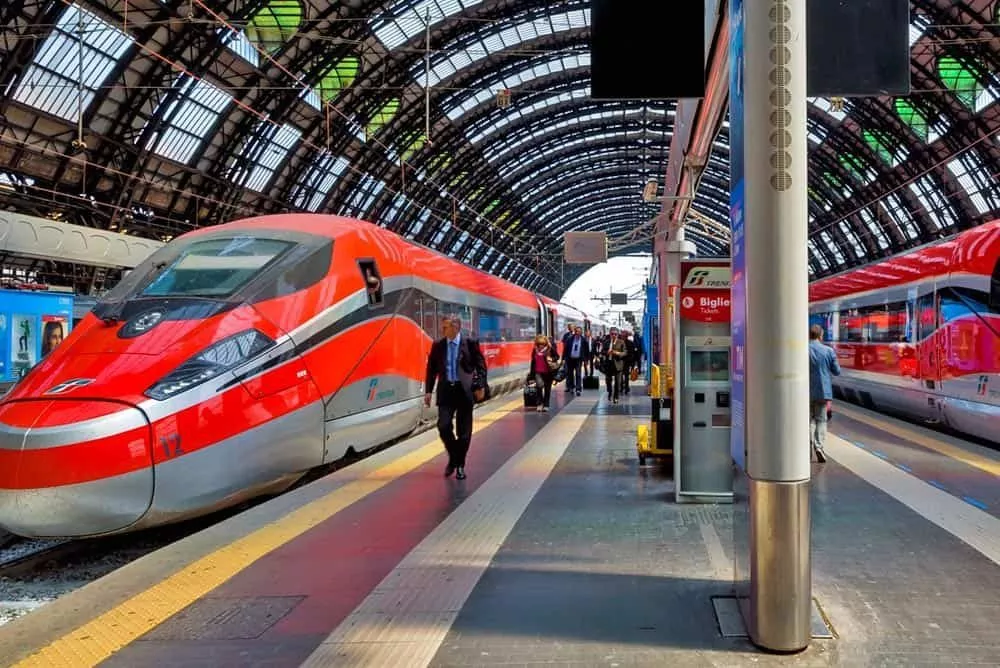
Traveling by train is the quintessential way to tour Europe. It’s romantic. It’s inspiring. It’s super-efficient. It’s comfortable. Some might say it’s almost magical. And to those who don’t live in a country where train travel is prominent, it’s a little mysterious.
In this Complete Guide To Train Travel In Europe, I’ll cover everything you need to know about traveling Europe by rail—including how to get the best price on train tickets, rail pass tips, understanding train schedules, tips for riding trains, how to navigate train stations, and advice for dealing with other issues you might encounter. By the end of this guide, you’re going to be a European train expert!
Quick Tip: Most train tickets are now electronic so you’ll want fast and reliable mobile data on your phone when traveling via train. Check out my guide on how to use your phone in Europe and our guide to the best SIM Cards and Data Plans for Europe .
The Pros and Cons of Europe Train Travel
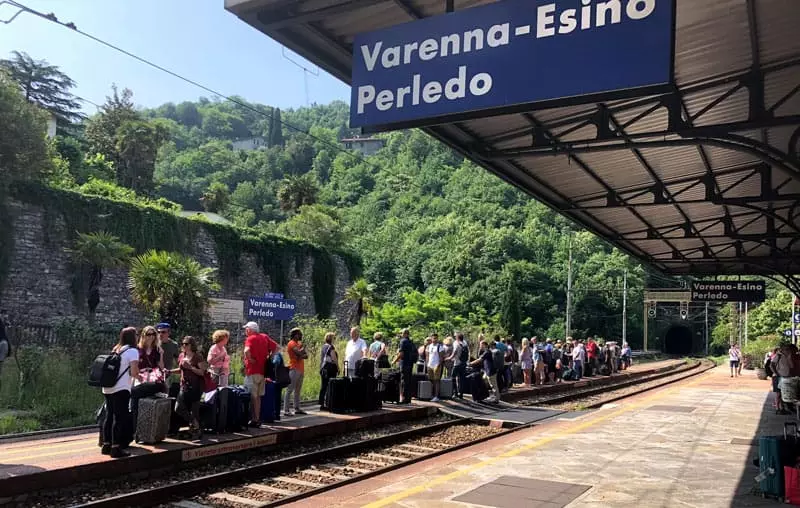
Let’s start with a quick overview of the positives and negatives of train travel in Europe.
Advantages Of Train Travel In Europe
Here are all the things I love about riding the train in Europe:
- In contrast, traveling from the airport to the city can take anywhere from 20-60 minutes and costs between $10-$80.
- There are no lengthy check-in procedures or security screening for most train travel. You simply show up a few minutes before the train leaves, buy a ticket if you don’t have one, and hop on the train.
- There are no luggage weight limits or extra fees for multiple pieces of luggage—just make sure that you’re able to lift your bag onto the train.
- Most European trains now accept electronic tickets—you simply show your ticket on your phone. That means no waiting in ticket lines and it makes planning your train travel even easier.
- You can pretty much bring whatever you want on a train—including alcohol. So stop by the local grocery store and pick up some cheap food for the journey.
- Europe’s rail network is extremely vast so it is possible to travel to even small towns by train. Most destinations offer multiple trains a day. The most popular routes usually have multiple trains an hour so getting to where you want to go is rarely difficult.
- If you’re traveling a long distance, consider taking an overnight train. These trains have special sleeper cars with bunks (usually six-bunk rooms or two-bunk rooms). A bunk in a sleeper car will cost about $45-$90 extra (about the same as a night in a hostel) but you won’t lose out on a whole day of travel. Overnight trains also have normal seats if you don’t want to fork over the extra cash for a bunk but it’s kind of uncomfortable.
- Train travel allows you to be spontaneous so you can show up at any train station, buy a ticket, and be on your way.
- Europe has a lot of beautiful countryside so traveling by train is a great way to see some fantastic views.
- Some trains also offer designated quiet cars if you truly want quiet.
- Train seats are larger and more comfortable than plane seats (especially when compared to many discount airlines). You’re also free to move about the train whenever you feel like it. Many trains also have seats that face each other and have a table between the seats—so it’s great for groups.
- European trains run on schedule well over 90% of the time but flights are only on schedule around 65%.
- Historically, train stations were the central hub for commerce and transportation so European cities showed off their status by building grandiose train stations. While it isn’t a huge deal, it is one of those nice little perks.
- Many countries offer sizable discounts for people under 26 years old so don’t forget to look into those discounts.
- The train is the most environmentally friendly form of travel. In fact, even France banned short-haul flights to encourage more train travel within France.
- We’ve always found riding the train to be fun. It’s oddly magical and relaxing.
Disadvantages of Train Travel in Europe
Train travel isn’t perfect so here are a few things to watch out for:
- That said, you can get some really good deals if you’re able to book high-speed trains in advance but you’ll pay a premium if you book last minute.
- There are often discounts for travelers under 26 years old.
- Note: Don’t forget to add in travel time to/from the airport and time to get checked in and through security—which will add around three hours to your journey.
- The train schedules can be a little confusing—especially for beginners. Luckily, there are plenty of apps that help make the process much easier but we still get tripped up every now and then.
- Many cities have more than one train station (Paris has six!). It’s not uncommon to arrive at one station and leave from another.
- It is also possible to change stations during a single journey. For example, when traveling from London to Lyon via the Eurostar, the Eurostar stops at the Paris North station, but then you have to travel to the Paris East station to catch the train from Paris to Lyon because there are no direct trains from London to Lyon. This transfer would require a cheap Métro (subway) ride.
- Striking is a national pastime in Europe. It happens a few times a year (or more if the people aren’t happy) but they announce the strikes well in advance so it shouldn’t be a surprise (just a hassle). You’ll just have to deal with them if they happen.
Pre-Trip Train Journey Planning
There are a number of great websites that will help you plan your train journey.
The first is Rome2Rio — simply plug in your destinations and it will give you all the train routes (as well as plane, bus, and car routes with cost estimates and travel times) for your journey. Rome2Rio is good for comparing different modes of transportation but I find better train ticket prices and more complete train listings on Omio and Trainline .
The German Railways Website ( Bahn.de ) shows the schedule of every train in Europe (yes, every train). We find that it’s helpful for piecing together complex train journeys. But it’s also good for seeing which trains require reservations and other important information. Unfortunately, you can only book German train tickets on the site so hop over to Omio and Trainline to book your tickets.
I’ve also written a few country-specific train guides to help you learn the quirks of each country’s rail network.
- Belgium Train Guide
- England Train Guide
- France Train Guide
- Germany Train Guide
- Italy Train Guide
- Netherlands Train Guide
- Portugal Train Guide
- Spain Train Guide
- Switzerland Train Guide
How to Buy European Train Tickets
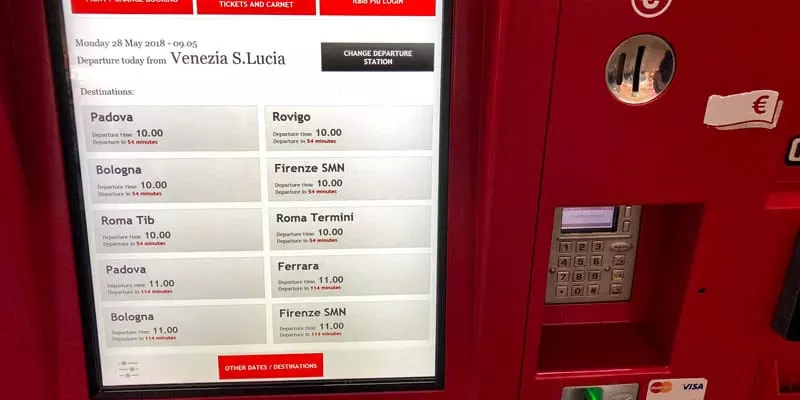
Buying European train tickets can be a little complicated—especially when you’re looking for the best deals.
That’s because each country runs its own National rail service (many countries also have separate private rail networks as well) and each does things slightly differently.
Luckily, there are plenty of online tools to make the whole process easier and we’ll walk you through the process.
NOTE: I’ve written an in-depth guide on how to buy train tickets in Europe if you want a more detailed look at finding the cheapest train fare.
How To Understand Train Ticket Pricing
Before we get started, I need to explain the two main ways train tickets are priced— fixed price and variable price .
Variable-Price Train Fares
Variable Train Fares are always changing based on demand, the day of the week, the time of year, and the distance to the departure date. Essentially all high-speed trains operate on this pricing model.
- In general, the prices will continue to creep up as the departure date approaches—you’ll pay a fortune if you buy last minute.
- Of course, you lose flexibility when buying tickets in advance because the cheapest tickets are normally non-refundable/unchangeable
Fixed-Price Train Fares
With Fixed Train Fares , the price is solely determined by the distance traveled. This is most common on regional and slower trains. With this type of ticket, it doesn’t matter when you buy tickets because the price never changes.
Where To Buy European Train Tickets
There are two main ways to buy European train tickets—directly from each country’s National Rail Service (via their website or at the train station) or through a third-party train booking search engine like Omio and Trainline —I find these booking services to be much more user-friendly.
Third-Party Train Ticket Booking Sites
There are quite a few advantages to buying your train tickets with third-party booking sites:
- The advantage of booking with a third-party booking site is that it lets you book more complex multi-country/international train routes. Many National Rail Services have trouble booking international routes (i.e. going from France to Italy)—so they can’t always find the best deals or show all available routes.
- Many of Europe’s National Rail websites still have issues processing foreign credit cards so it’s common for credit cards to be declined when booking. These third-party sites won’t have these issues.
- We’ve found that it’s common for Europe’s National Rail websites to be plagued with weird technical problems and overall poor user interfaces. Many times you’ll get kicked from the English version of the page to the local language in the middle of the booking process. These third-party booking websites take care of these issues.
- Third-party booking services have much better smartphone apps than the clunky national rail service apps.
Our Favorite Train Booking Websites
- Omio : Omio is a great train booking engine that lets you book tickets from just about every country’s rail service and they make the booking process very user-friendly.
- Trainline : Trainline is a new European train booking service (very similar to Omio ) that sells train tickets from Austrian, French, German, Spanish, Italian, and German Railways railways (and a few others).
National Booking Sites
Despite their technical issues, sometimes the cheapest tickets can only be found by booking directly with each country’s national rail service. This is because sometimes they offer limited-time deals that third-party booking sites don’t have access to. So it doesn’t hurt to at least take a look.
Links to Some National Railway Websites:
Austrian Railways ¹ – Belgian Railways ¹ – Danish Railways – Finnish Railways – French Railways – German Railways – Irish Railways – Italian Railways – Spanish Railways – Netherlands Railways ¹ – Norwegian Railways – Polish Railways – Swedish Railways – Swiss Railways ¹ – United Kingdom Railways
¹ Domestic tickets (i.e. trips that are wholly within the country) are always the same price — regardless of when they’re purchased and they never require a reservation. Therefore, it is easiest to buy tickets at the station. However, these countries often have a separate international high-speed train system (e.g., Belgium has slower regional trains and high-speed Thalys trains that link major Belgian cities to other international cities — these tickets should be purchased early for cheaper fares).
Quick Note About Eastern Europe Trains
Some Eastern European countries still don’t have online ticket booking so it’s only possible to purchase tickets at the station or through a local travel agent. Ask your hostel or hotel and they’ll tell you where to locate an agent.
Receiving Your Online Tickets
There are multiple ways to collect your tickets after you purchase them:
- Electronic Tickets: Many times you can have an electronic ticket sent to your phone (either via email or the booking app). Simply show the conductor on the train when he checks tickets and he’ll scan the QR code on the screen. This isn’t available in all countries but most countries have switched to eTickets.
- Print-At-Home Tickets: Anywhere that offers electronic tickets will usually let you print tickets at home. You can often simply save the PDF to your phone/tablet and the conductor can scan it from there.
- Note: You’re often required to use the SAME credit card use to purchase the tickets to collect the tickets at the station.
Buying Tickets At The Station
You can buy train tickets at any train station—either from the ticket window or from automated ticket machines. We recommend trying the automated ticket machines since the lines at the ticket window are long, slow, and understaffed.
When To Buy Train Tickets To Get The Best Price
Fares are fixed for most regional and local trains so there is no reason to buy them early.
For high-speed trains , it’s best to buy tickets early to get the cheapest tickets. In most cases, train tickets can be purchased 60-90 days before the departure date but buying a few weeks early is usually fine.
Train Ticket Price Examples (Comparing Last Minute vs Buying Early)
- Purchased Two Days Before Departure: €69.00
- Purchased Three Weeks Before Departure: €55
- Purchased Two Days Before Departure: €135
- Purchased Three Weeks Before Departure: €97
- Purchased Six Weeks Before Departure: €54
- Purchased Two Days Before Departure: €234
- Purchased Three Weeks Before Departure: 124
- Purchased Six Weeks Before Departure: €55
As you can see, booking just a few weeks early can save quite a bit of money.
Quick Point About Buying Train Tickets Early : As stated above, buying tickets in advance is the best way to save money but this also limits your ability to be flexible/spontaneous. This is especially true since many of the truly cheap train tickets are non-refundable. For optimum flexibility, it might be best to buy a rail pass. Here’s my Guide To Using Rail Passes in Europe and my Eurail Pass Review .
Other Train Ticket Discounts
Most rail services offer various discounts—some are based on rider age but other discounts are based on region, the day of the week, or other schemes.
- The most common discount is a youth discount — which is usually for people under 27 years old.
- Most countries offer a number of potential discounts. For example, Germany has a Schönes-Wochenende-Ticket (Happy Weekend Ticket) where groups of 2-5 people can ride as much as they want on regional trains from Saturday to Sunday for €44. Check each country’s rail service website to see if there are discounts available.
Eurail Passes
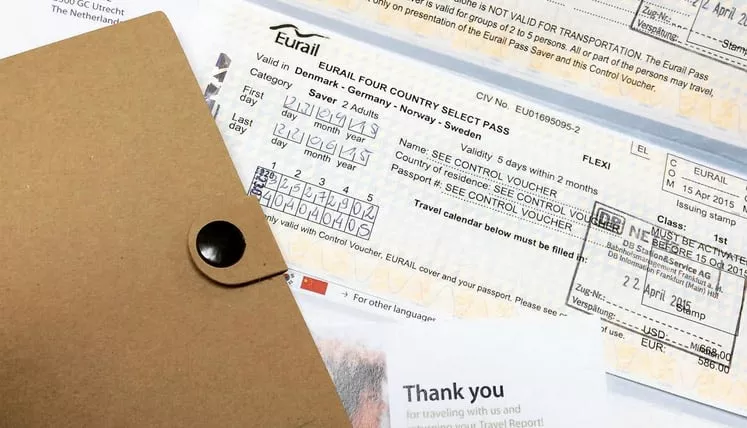
Many travelers choose to use rail passes instead of buying individual tickets. That’s because Eurail passes can save you a bit of money (depending on how you use them) but most importantly they give you excellent flexibility by allowing you to travel without needing to plan.
Note: We’ve written a lot about Eurail Passes. Check out our Guide To Using Rail Passes in Europe and our Eurail Pass Review for more in-depth information.
Quick Rundown On Rail Passes
A rail pass (aka Eurail Pass) is a single ticket/pass that allows you to ride any train in Europe—simply hop on, show the conductor your pass, and you’re good to go. Actually, it’s not quite that easy these days as there are a few stipulations, but the general idea is that you can ride any train without booking individual tickets.
Types Of Rail Passes
- Continuous: Unlimited travel to any Eurail participant country for between 15 days and 3 months.
- Flexi: 10 or 15 individual travel days (doesn’t have to be consecutive days) to any Eurail participant country within a two-month period.
- For example, one pass could be 10 days of train travel between France, Switzerland, and Italy. You have a two-month window to use of your 8 travel days. Each day you travel by train counts as one travel day but you can take unlimited train rides within each day.
- Eight travel days in a single country which must be used within a month.
Advantages of Rail Passes
- Flexibility: The number one benefit of rail passes is the flexibility they offer. You simply have to walk onto the train and go. That’s why this is a great option for people who don’t want to plan and who would rather wander across Europe.
- Long-Distance Trains: It’s also a good deal if you plan on taking a lot of long-distance trips because those tickets tend to be expensive so a rail pass is a good way to save some money. On the other hand, if you’re taking a bunch of short train rides then you’ll probably be better off buying single tickets.
- Low Stress: Piecing together a bunch of train journeys and then pre-purchasing individual tickets is stressful and takes a lot of time and planning. For a lot of people, paying a little extra for a rail pass is worth the hours saved having to preplan your entire trip.
Disadvantages of Rail Passes
- More Expensive: It’s usually cheaper if you purchase your train tickets online a few weeks in advance. That said, most of these cheap pre-purchased tickets are non-refundable so you’ll lose most of your flexibility. However, if you’re purchasing your train tickets a few days before departure then it’s much cheaper to use a rail pass.
- Reservations: A few countries require rail pass holders to pay extra for a seat reservation on high-speed trains. The fee can range from anywhere from €5-€35 and they have to be made in advance — they can sometimes be made online or directly at the train station. Here’s a detailed guide to rail pass reservation requirements from eurail.com. You can also enter your journey into Bahn.de and it will tell you if that specific journey requires a reservation.
Navigating The Train Station
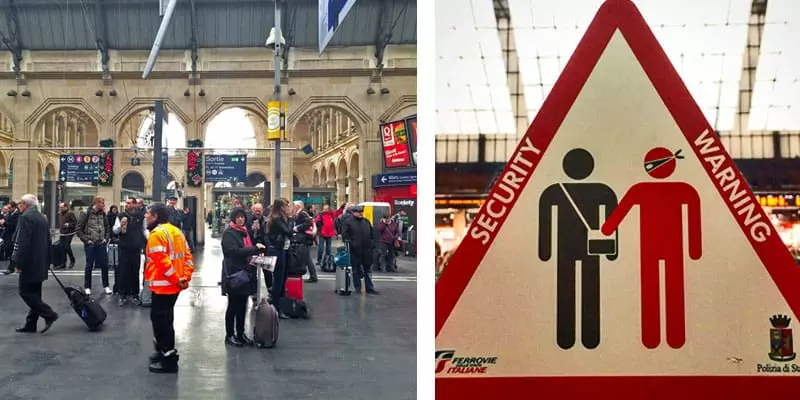
Ok, now we know how to buy train tickets and rail passes… so let’s learn about what to expect when you get to the train station.
The train station is the central transportation hub of most European cities so things can be a little chaotic and confusing—especially if you’re not used to traveling by train.
In this section, I’ll give you some tips to help you find your train.
First, make sure you have the correct train station because many cities have multiple stations. For example, Paris has six stations. Even some small towns have two different stations.
Once you arrive at the station, you’ll see signage in English so you shouldn’t have much trouble finding your way. Some stations are huge so you may have to walk quite a bit and navigate stairs and escalators.
Depending on the size of the station, you’ll also find fast food, cafes, shopping, lounges, and restrooms (although you sometimes have to pay to use them). Also, most train stations have luggage lockers that you can rent if you need them.
Pickpockets and Scams at the Train Stations
Train stations can get very busy, hectic, and full of confused tourists so they’re a common target for pickpockets and other scammers. Pay attention to your stuff and be wary of “helpful” strangers willing to help you with the ticket machines. Check out our Guide To Avoiding Pickpockets and Tourist Scams in Europe .
Train Ticket Machines

If you need to buy your train tickets or print your pre-purchased tickets you’ll want to first head to the automated ticket machines. Everything is in English and the machines are easy to use.
Alternatively, you can still go to the ticket window or customer service desk but the lines are usually long.
Reading The Train Station’s Departure Board
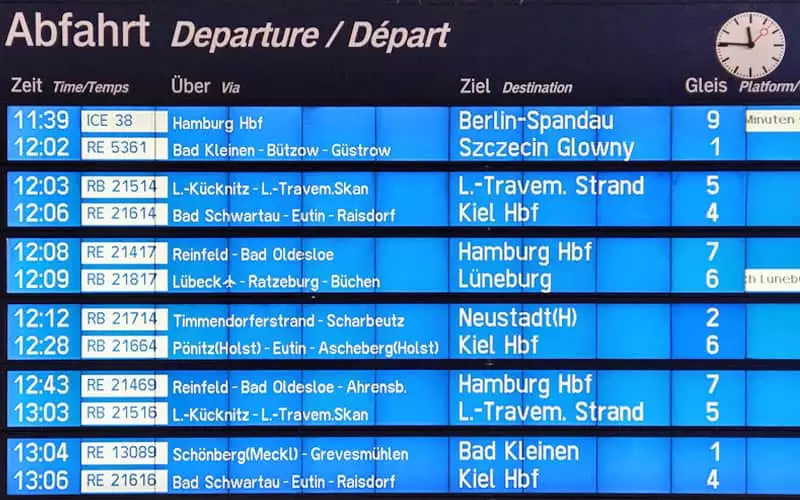
Once you arrive at the station you’ll want to look for the departure board. There are usually multiple boards throughout the station and one giant main board. This board tells you where to find your train, when it leaves, and where it’s going.
The three most important things to note are the train number , departure time , and the platform .
Your train ticket will show the scheduled departure time and the train number but it usually won’t show which platform the train leaves from.
So head to the departure board and find your train number to see at which platform your train is located. It’s very common for the departure board to not display the platform until 10-15 minutes before departure so pay attention to the board.
Find Your Train’s Platform
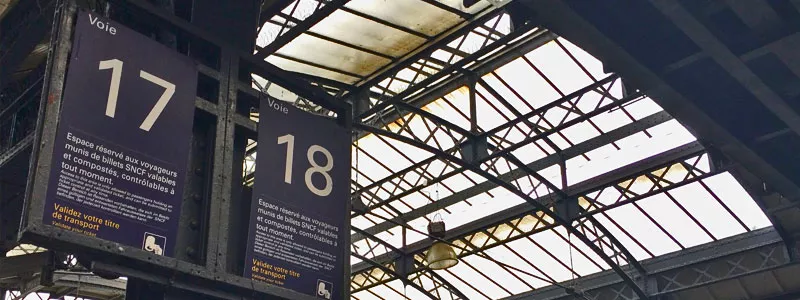
Once know what platform your train is departing from you’ll want to find that platform at the station. Sometimes the platforms are a bit hard to find so you might have to seek them out.
Don’t worry if there isn’t a train there at the moment because trains often pull in, load up, and leave.
There are usually a few staff members milling about on each platform so don’t be afraid to ask train station staff as most can speak English.
Validate Your Ticket
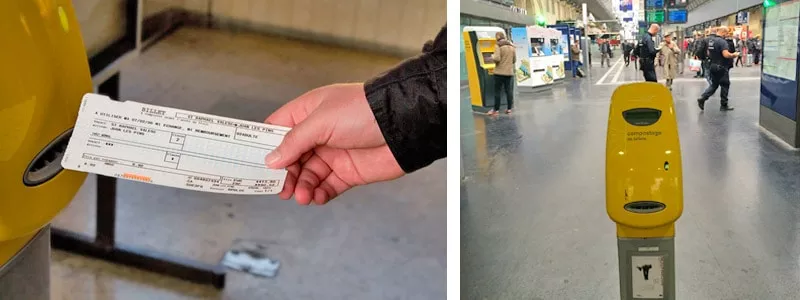
Many physical train tickets need to be validated (stamped with time/date) before entering the train so look for small validation boxes near the entrance of the platforms. Simply place your ticket inside the machine and it will stamp it.
You can receive a large fine if the ticket checker sees that your ticket isn’t validated (they’ll assume you were trying to ride for free). If you forgot, quickly seek out the conductor, explain that you forgot to validate and everything should be fine. Or you can just play the “I’m a dumb tourist and these scary trains confuse me” card and hope they let it slide.
Note: Electronic tickets don’t need to be validated because they’re usually only good for the specific time stated on your ticket. Some paper tickets also don’t need to be validated but we usually try doing it anyway to be safe.
Finding Your Train Car
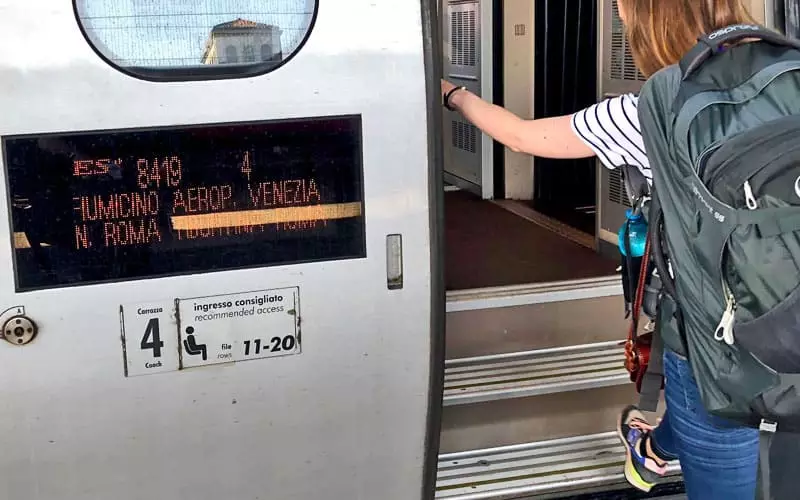
On some trains (usually high-speed trains) you have assigned seats so look at your ticket to see which train car your seat is in. The car number will be displayed on the side of each train car.
You can board the train in any car but it’s much easier if you enter your car (walking through multiple train cars is a pain).
Most regional and slower trains don’t have assigned seats so you can simply board anywhere you like.
That said, you’ll want to get on fairly quickly because trains are usually only at the station for a few minutes before they leave.
On The Train

You’ve made it on the train. Congratulations! In this section, we’ll talk about settling in and a few things you might experience on your ride.
Find Your Seat & Store Luggage
Find your assigned seat (if you have one) or take any free seat if it’s open seating. The seat numbers are displayed above the seats.
Take the opportunity to store your luggage. Smaller luggage like backpacks and some suitcases can be stored above your seat on luggage racks. There are usually larger spaces for bigger luggage at the end of each train car.
Wait For The Conductor To Check Your Tickets
A ticket checker will come by and check your ticket after the journey starts—typically within 10-20 minutes after departure.
While not extremely common in Western Europe, border patrol might board the train to check passports. They might ask you some questions but we usually only encountered this in Eastern Europe.
Enjoy The Ride
One of the great things about train travel is the comfort of the ride. Feel free to walk about, check out the bar car, enjoy a picnic (alcohol is allowed), or sleep. Some trains offer free wifi but we’ve never had much luck getting it to actually work.
Departing The Train
One of the most confusing parts of the ride is knowing exactly when to leave the train. That’s because train stations are sometimes named very similarly.
For example, many trains coming into Brussels first stop at the Brussels Nord station (which is located on the outskirts of town) before stopping at the main Brussels Centrale station (which is located in the center of town).
More Europe Travel Tips From The Savvy Backpacker

I have a lot more tips and tricks for traveling through Europe on a budget. Here are a few helpful articles I think you’ll enjoy.
- Get moving with our picks for the Best Travel Backpacks .
- Get packing with our Europe Packing List .
- Get traveling with our Europe City Travel Guides .
- Get planning with our step-by-step Guide To Traveling Europe On A Budget .
- Get a High-Speed eSIM Data Plan for Europe and learn more about how to use your phone in Europe .
- Recent Posts
- How To Buy Train Tickets in France | Guide To Buying French Train Tickets - July 26, 2024
- France Train Guide — How To Travel France By Train - July 25, 2024
- Best Prepaid USA eSIM Data Plans For Travelers | eSIM Buyer’s Guide - July 3, 2024

No Funny Business
The Savvy Backpacker is reader-supported. That means when you buy products/services through links on the site, I may earn an affiliate commission—it doesn’t cost you anything extra and it helps support the site.
Thanks For Reading! — James
Questions? Learn more about our Strict Advertising Policy and How To Support Us .
Related Reads
How to buy train tickets in france | guide to buying french train tickets.
What you need to know about booking train tickets in France and tips for getting the cheapest prices.
France Train Guide — How To Travel France By Train
How to travel France by train—tips for buying French train tickets and advice for navigating France by rail.
How To Purchase Train Tickets for Europe | Strategies For Buying European Train Tickets
Tips on the easiest and cheapest ways to buy train tickets in Europe.
Italy Train Guide — How To Travel Italy By Train
How to travel Italy by train — tips for buying Italian train tickets and advice for navigating Italy by rail.
City Guides
Choosing travel insurance, travel packing lists, budget travel newsletter.
The best budget travel tips sent straight to your inbox.
Join My Journey
Europe travel tips, advertising & privacy policies.
TheSavvyBackpacker.com is a participant in the Amazon Services LLC Associates Program, an affiliate advertising program designed to provide a means for sites to earn advertising fees by advertising and linking to amazon.com.
© 2010 - 2024 The Savvy Backpacker
Website Design by FHOKE
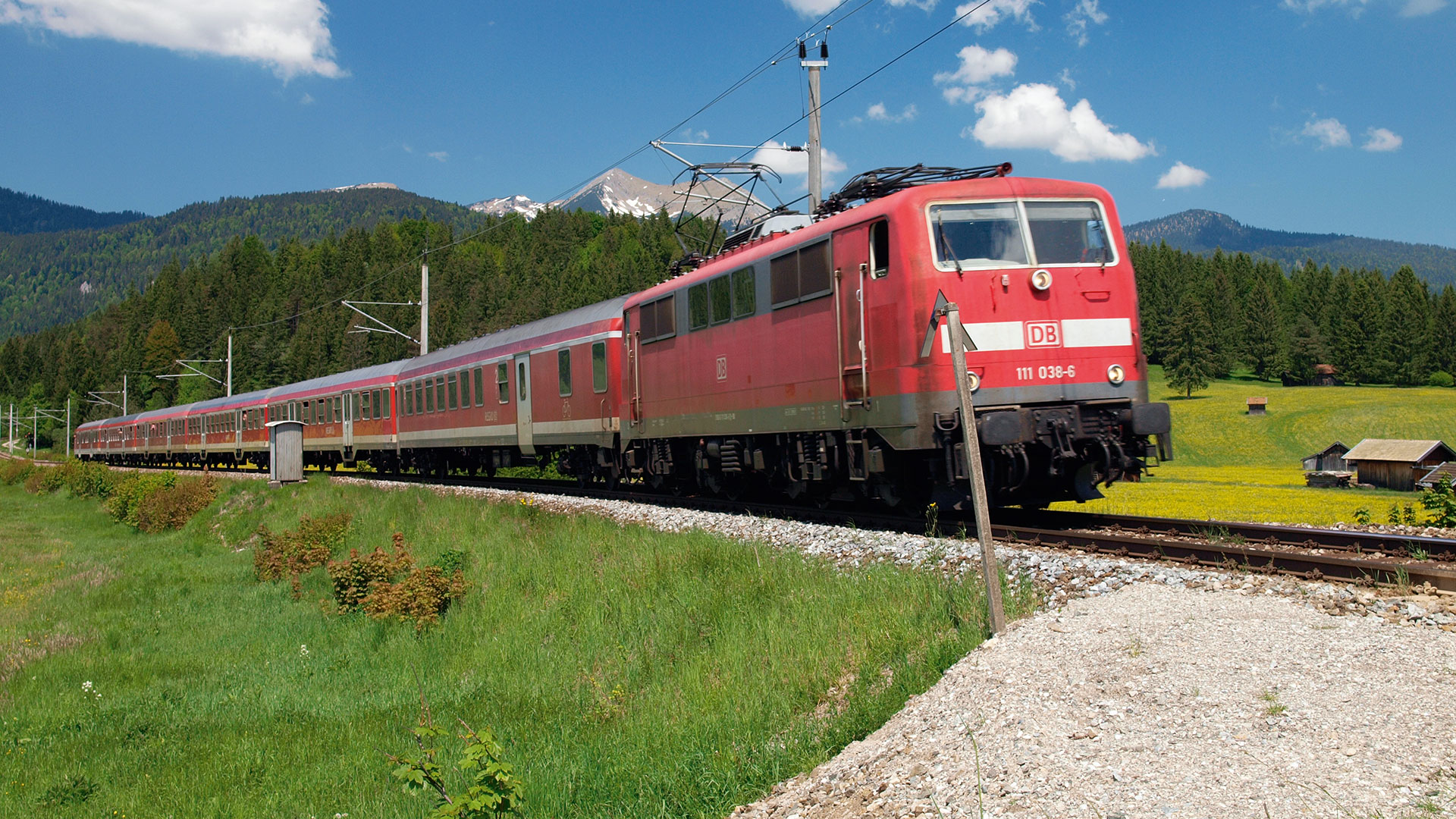
Welcome to Europe by Rail
Exploring Europe by train is easy, economical and enjoyable. Europe by Rail is a guidebook featuring fifty great routes, country information and off-beat diversions. It'll inspire you to explore Europe in a way you've probably never done before.
The 17th edition of Europe by Rail was published on 12 April 2022. The book was reprinted in September 2022 and July 2023.

What people have said about recent editions of the book
The continent of Europe is a vast land that is rich in diversity, history and culture. There are borders of course, yet Europe by Rail teaches us to see borders not as obstacles, but instead as open doors to new and different experiences.
Europe by Rail has been in existence for over a quarter of a century, but with each new edition Nicky and Susanne have continued to refine what is not only the finest guidebook to rail travel across this continent of ours, but also one of the best guides to travel in Europe full stop.
This guide most certainly lives up to its name: it is a most definitive guide, and is packed with all the information that you will need to plan your rail travel across the continent. Do not leave home without it.
Europe by Rail is a book of sheer possibility, a love letter to a continent that also tells you where to buy the ring and how to get to the jeweller's.
Whether you use it vicariously, imagining trips from the comfort of home, or as an essential part of your travelling kit, Europe by Rail is a wonderful publication, proving that we don't have to fly thousands of miles to find adventure when there's so much to see at our doorstep.
If you’re planning to travel by train in Europe, “Europe By Rail” is your one-stop-shop resource that’s filled with everything you need to know.
This fifteenth edition is not just a guide to European train journeys (50 of them) but it’s a cornucopia of useful information about rail travel in general. Even if you don’t intend to travel by rail regularly, there is plenty of in-depth writing to whet your appetite from your armchair.
Gardner and Kries have packed this new edition with invaluable information on European train travel. But they have also managed to capture the joy, excitement, and even romance of train travel in what could have been an otherwise dry reference guide.
If you love train travel as much as we do, this book is more than just a guide for your bookshelf. Snuggle down with it on the sofa, or pull it out of your bag on a crowded commute home–then promise yourself you’ll use it to discover just how magical train travel can be.
Whether you are planning on taking just one or two rail journeys in Europe or will be covering much of the continent onboard a train, Europe by Rail is a must-read. Both rail novices and experienced train travellers will appreciate the tips and information included in the book.
This new edition should appeal in particular to members of the engineering profession, always defined by the two parameters of precision and creativity (or passion if you wish). Europe by Rail is resplendent with both. While brimming with the latest thoroughly verified bits of information, it is written with genuine gusto by the people who are not only extremely fond of travelling, but also happen to be accomplished stylists and writers.
Can you lose yourself happily within the book’s pages, much in the same way that you would lose yourself in a town or a landscape that you are exploring for the first time? With Europe by Rail , the answer is a resounding yes: not only will you get new ideas of where to go, you will also find stuff to make you see familiar places in a fresh perspective.
For anyone planning to embark on a rail holiday in Europe, this guide is an invaluable companion. Even if you’ve travelled extensively by rail across the continent, things change regularly and it’s an easy way to bring yourself up to date. Don’t wait until you leave to buy it. The suggestions for stopovers and detours will help with your planning and you’ll have information at your fingertips about rail passes, supplements, connections and the like.
What comes across more than anything is a genuine love of Europe and a huge enthusiasm for exploring different countries and cultures. Living in Berlin, the authors are at the very heart of Europe, and the routes and diversions they suggest give everyone the chance to sample the excitement of having a whole continent spread out before us.
It’s a wonderful book – I love the idea of arranging a travel guide around rail journeys, rather than rail journeys merely being included as a means of getting from A to B. Over its 512 pages, it includes some 50 rail routes, which between them do an impressive job of covering the wealth of landscapes, cities, cultures and languages this continent has to offer.
Beautifully written, the book is both practical and inspirational.
The book is an alluring combination of evocative writing (“Speed soaks up detail as poppies in the fields of Flanders become a red haze”) and practical advice. Subtitled The Definitive Guide for Independent Travellers , it is also a history of Europe in 50 train routes.
Wenn es ein Buch in die 15. Auflage schafft, dann ist das schon ein großes Lob. Umso mehr, wenn es sich um einen Ratgeber handelt. Und ganz besonders, wenn der sich um etwas so – vermeintlich – Altmodisches wie Bahnreisen dreht.
The most comprehensive European railway guide, this book serves two separate purposes: As an inspiring book to read before you leave on your travels - and an essential guide to constantly refer to when you are actually travelling on the most beautiful trains and railway lines that Europe has to offer.
Last month, Nicky and Susanne’s latest project hit the shelves: the 15th edition of Europe by Rail: The Definitive Guide . As both editors and now publishers of the guidebook, Nicky and Susanne have brought their trademark attention to detail to all aspects of the new publication, and as always it is an absolute pleasure to read.
Each chapter is peppered with insights into culture and heritage, and practical information for making the most out of a journey. [...] Europe by Rail is a guidebook that proves both inspirational and informative.
Inside the book
A detailed guide for planning your rail journeys
The guidebook is packed with information you’ll need for planning your train journeys around Europe – be it a meandering trip using Eurail or InterRail or a quick break to just one destination. Detailed route descriptions and tips on fares and ticketing help you navigate your way around Europe’s rail network.
Our passion for rail travel
The authors of Europe by Rail are travel writers and slow travel aficionados. And they are passionate about rail travel. The book captures the essence of each journey. You’ll find facts, ideas and inspiration aplenty in well-penned prose which invites you to hop aboard and discover another side of Europe.
A good read
Whether you are planning a long journey by rail or are an armchair traveller, Europe by Rail has something for everybody. The book records the sheer variety of European life and landscapes – join us as we watch lakes, mountains and townscapes slip by beyond the carriage window.
Take time to explore
Most journeys within Europe are of a length where flying hardly makes sense. Modern and efficient rail services criss-cross the continent. Take time to stop off and explore places along the way. Rediscover the joy of being flexible. If a station looks inviting, why not hop off the train and see what the town has to offer?
The authors
Susanne Kries and Nicky Gardner know their way around Europe by train. The two women, both based in Berlin, are the editors of hidden europe magazine. In their work for Europe by Rail , Nicky and Susanne perpetuate a tradition of writing about rail travel which goes back to Victorian England and the work of Thomas Cook.
European Rail News
Keep up to date with new services with the latest edition of the European Rail Timetable . And see our own European Rail News & Notes, which highlights what’s new around the railways of Europe. European Rail News & Notes is published by the authors of Europe by Rail: The Definitive Guide .
Get occasional updates about the brand-new 16th edition of Europe by Rail which was published in mid-October 2019.
By registering you agree with our privacy policy . By default, our e-Newsletter is in html format. If you should prefer to receive a simple text version, just tick the box below.
Get updates on train services, the announcement of new routes and other rail travel related snippets in our European Rail News & Notes section.
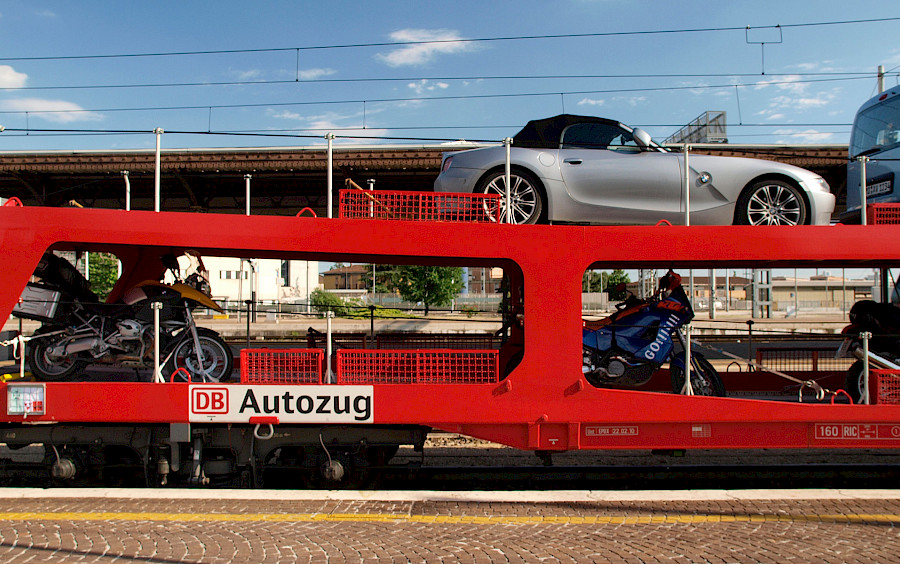
- ERT Newslines August 2024
Stay in touch

IMAGES
COMMENTS
A guide to train travel in Europe, how to check train times, fares, how to buy tickets, taking your bike, arrangements for children and luggage.
Planning an epic trip and want to learn all about train travel in Europe before you go? This guide will teach you exactly how to travel Europe by train!
Plan Your Train Trip. Rent a Car or Take the Train? Should I Get a Rail Pass? How to Choose Among Rail Passes. Buying European Train Tickets. Looking Up European Train Schedules and Routes Online. Train-Fare Maps: How Much Would You Pay Without a Pass?
A guide to train travel in the UK, Europe & worldwide. Train times, fares, how to buy tickets, tips & advice. How to travel by train from the UK to any country in mainland Europe, within Europe & around the world...
In this Complete Guide To Train Travel In Europe, I’ll cover everything you need to know about traveling Europe by rail—including how to get the best price on train tickets, rail pass tips, understanding train schedules, tips for riding trains, how to navigate train stations, and advice for dealing with other issues you might encounter. By ...
Exploring Europe by rail is easy and enjoyable. The guidebook Europe by Rail is the definitive guide to the best routes and places to visit, along with tips on ticketing, fares and accommodation. Researched and written by two of Europe's leading travel writers.